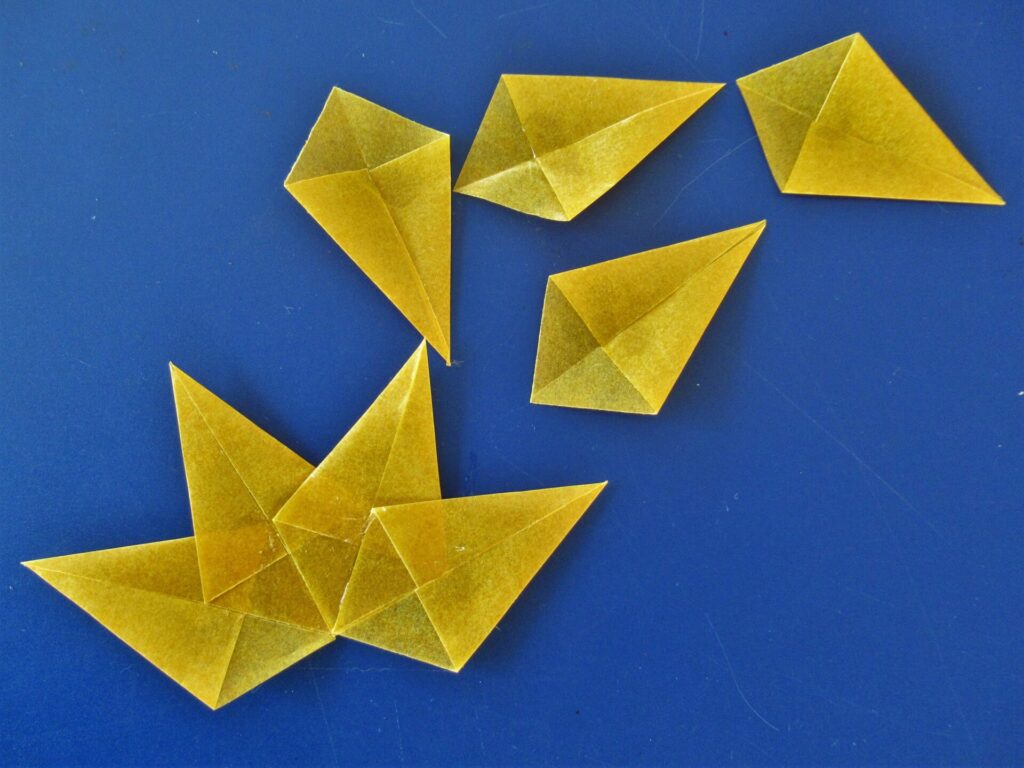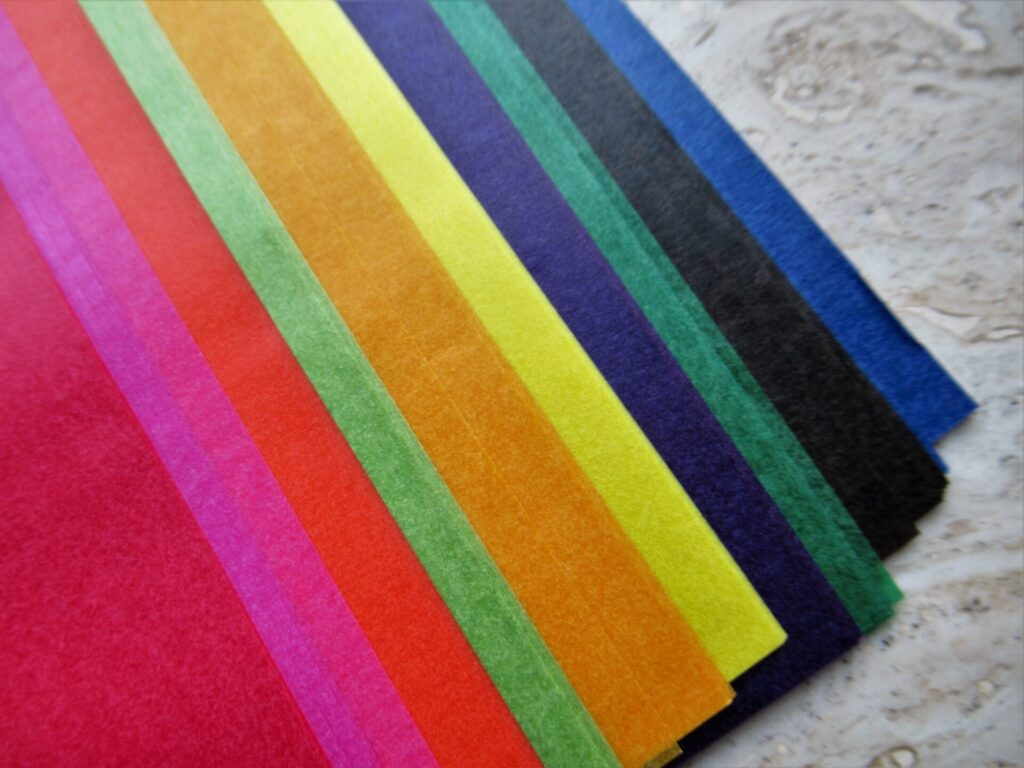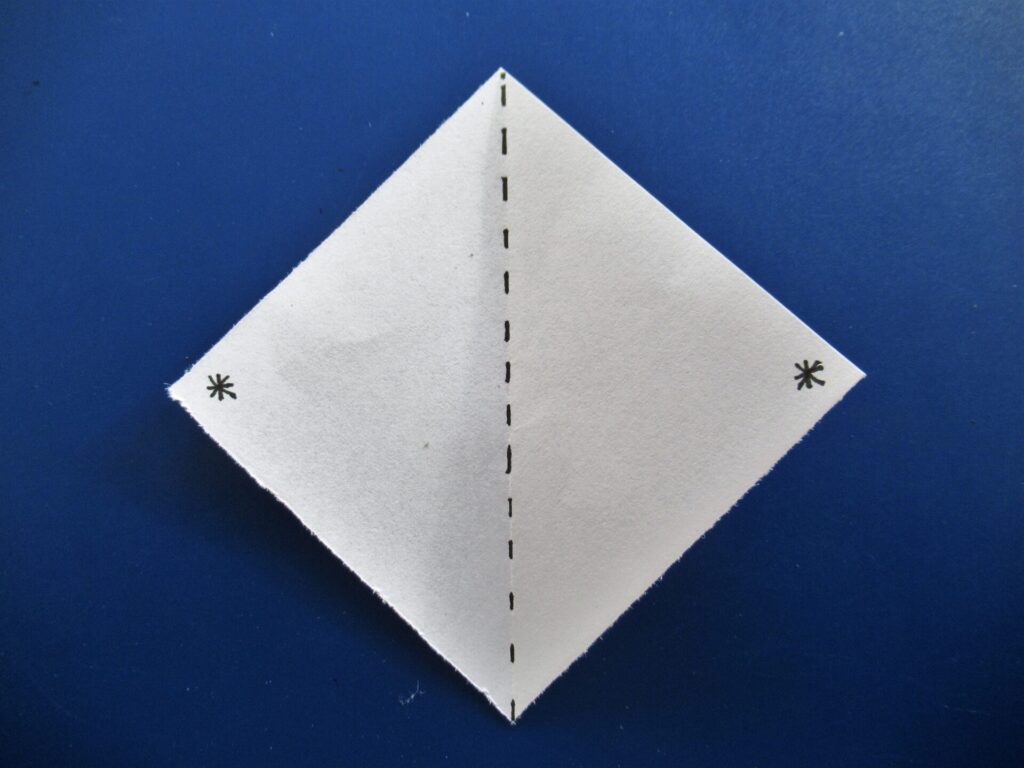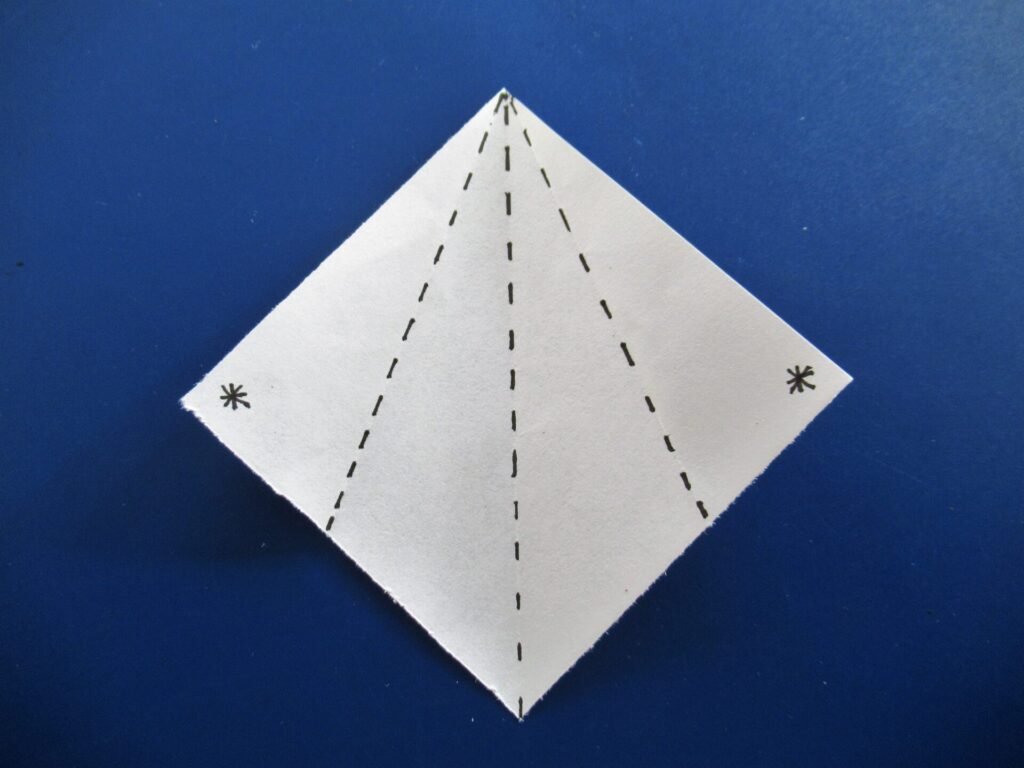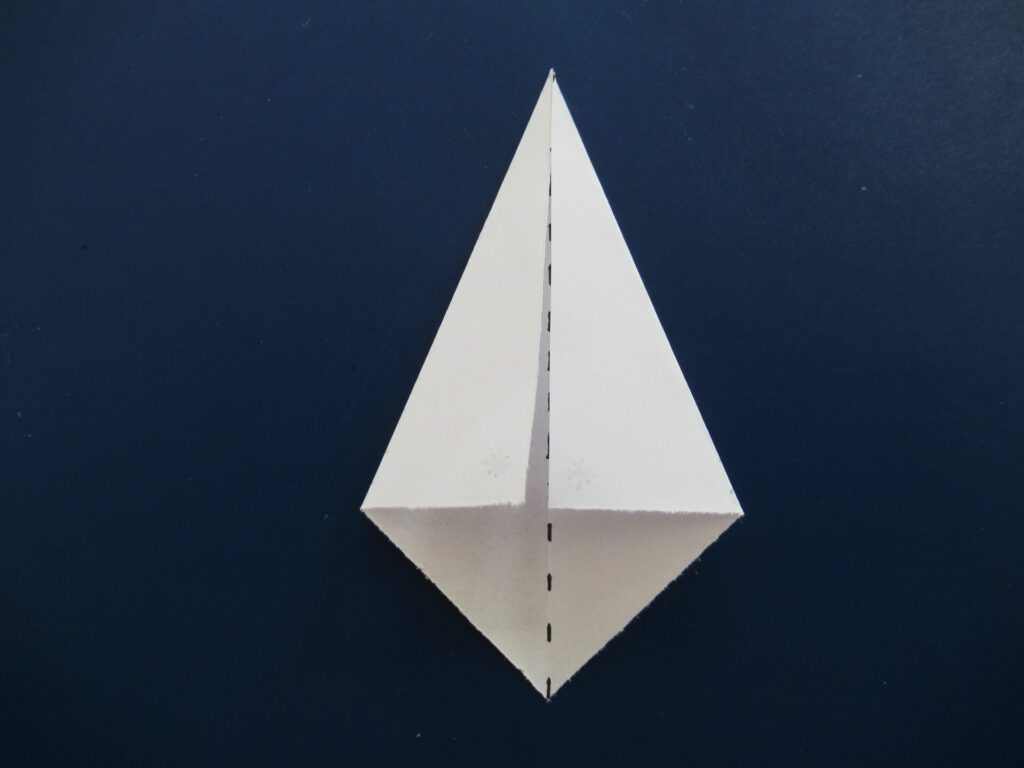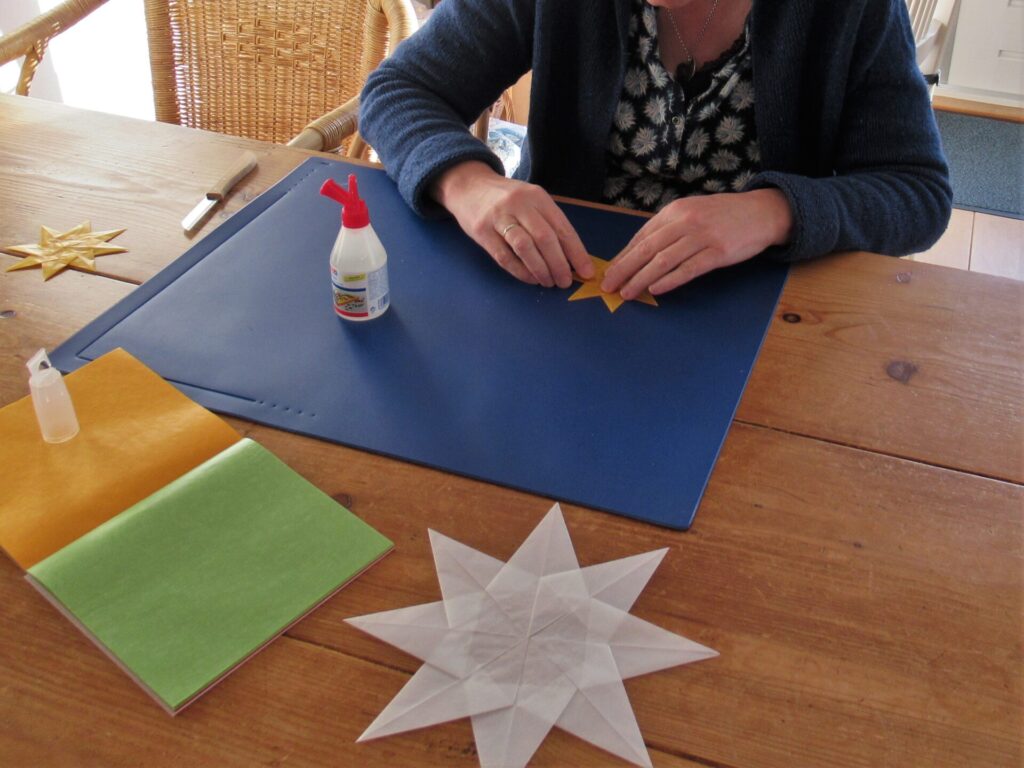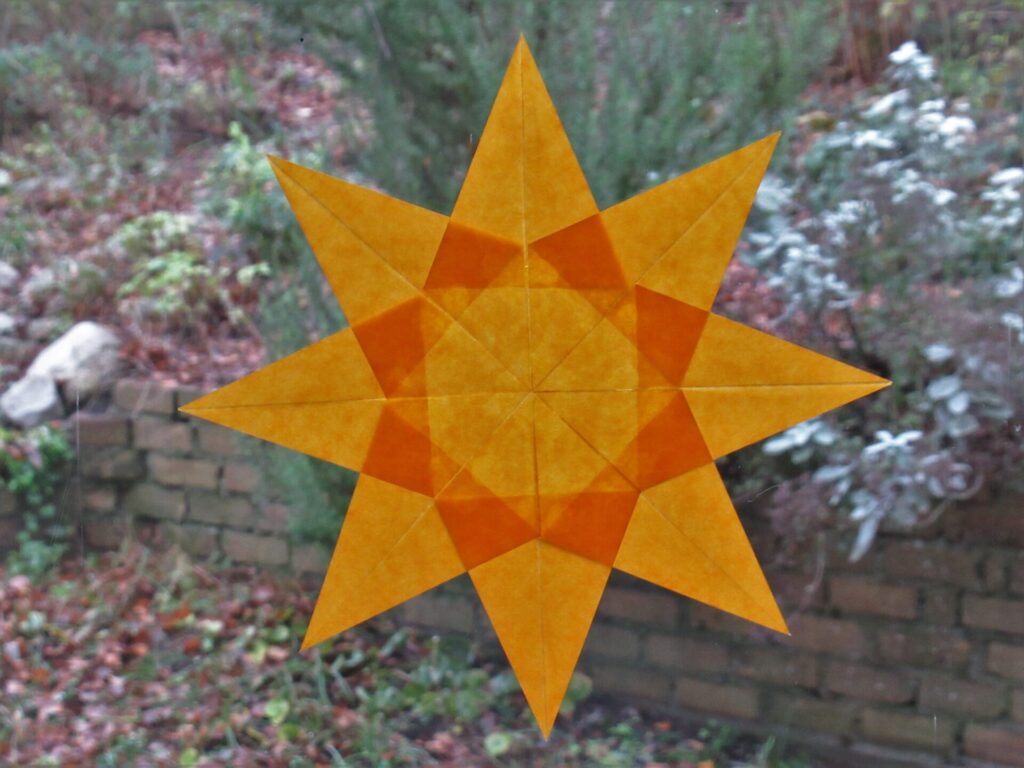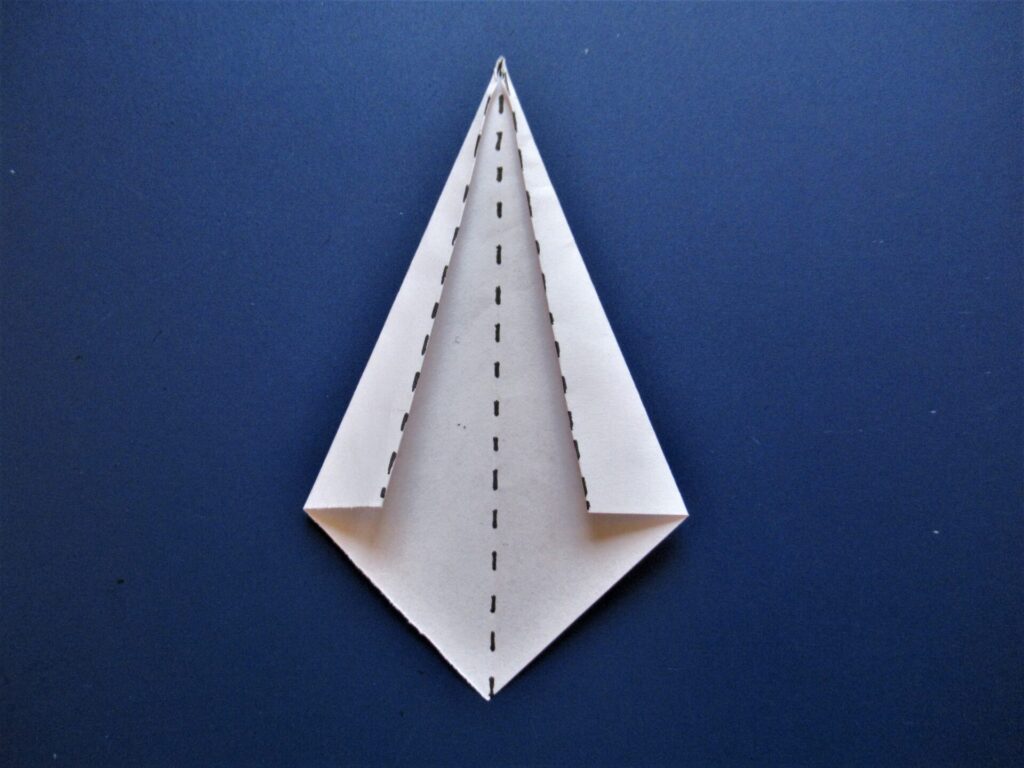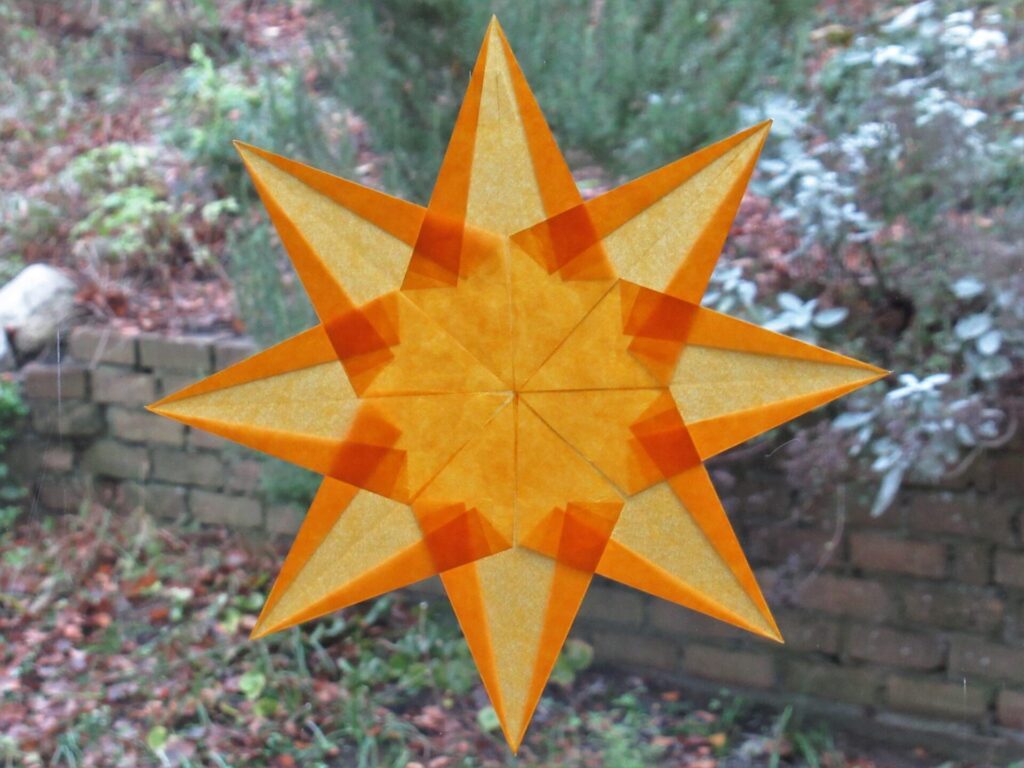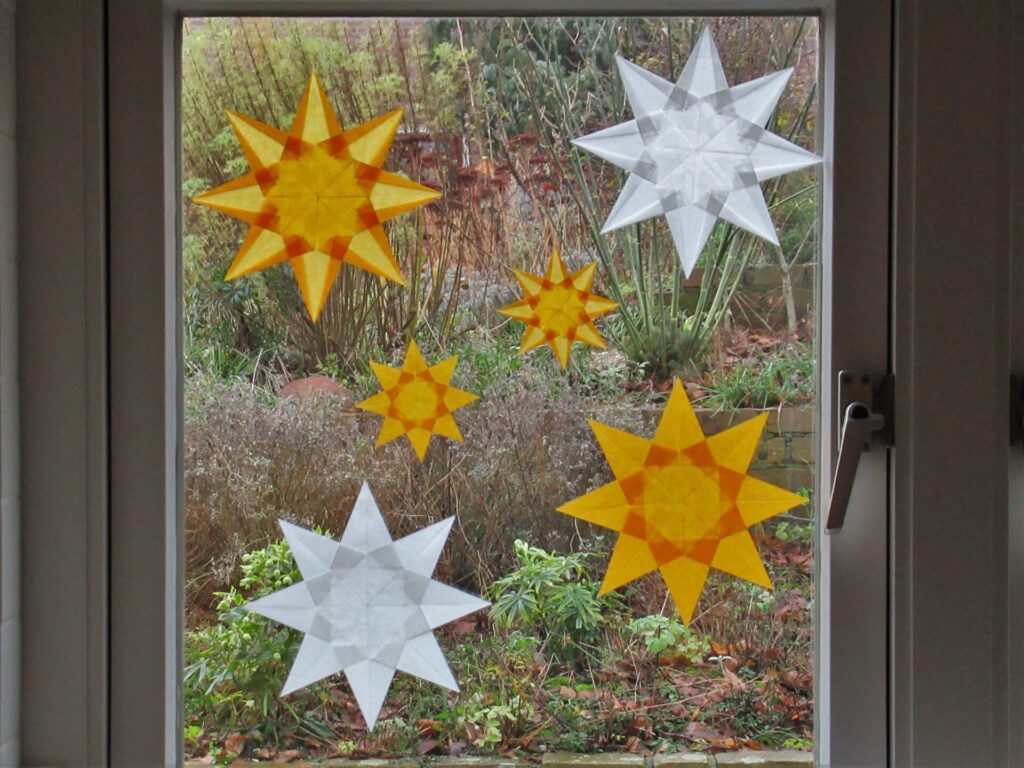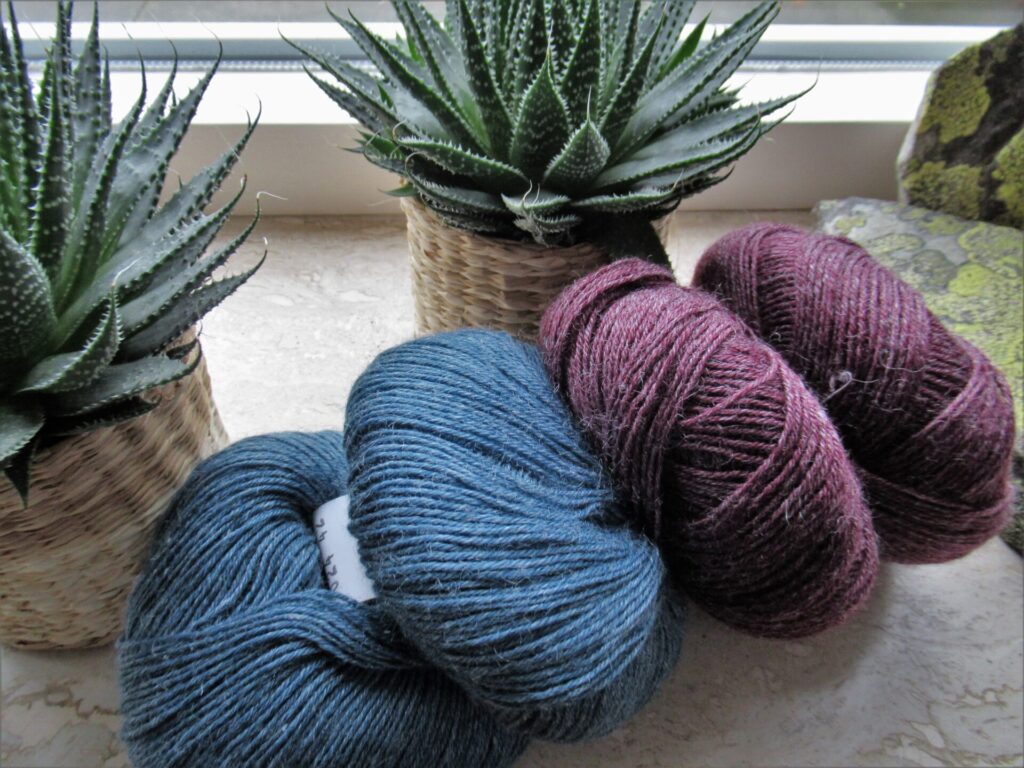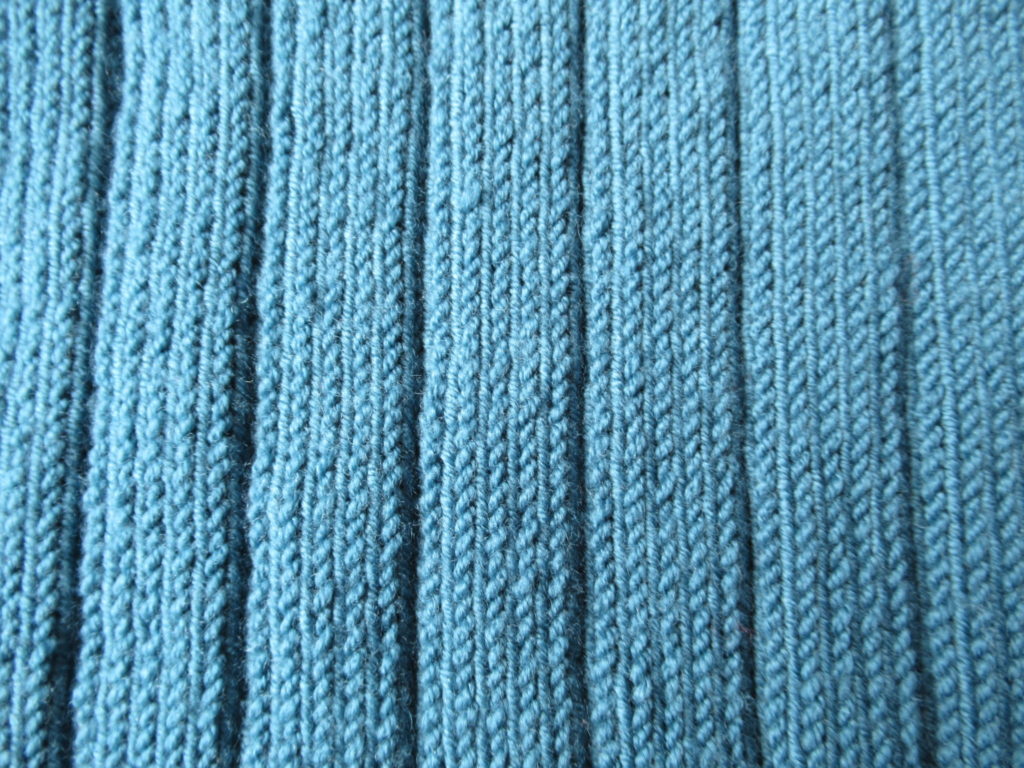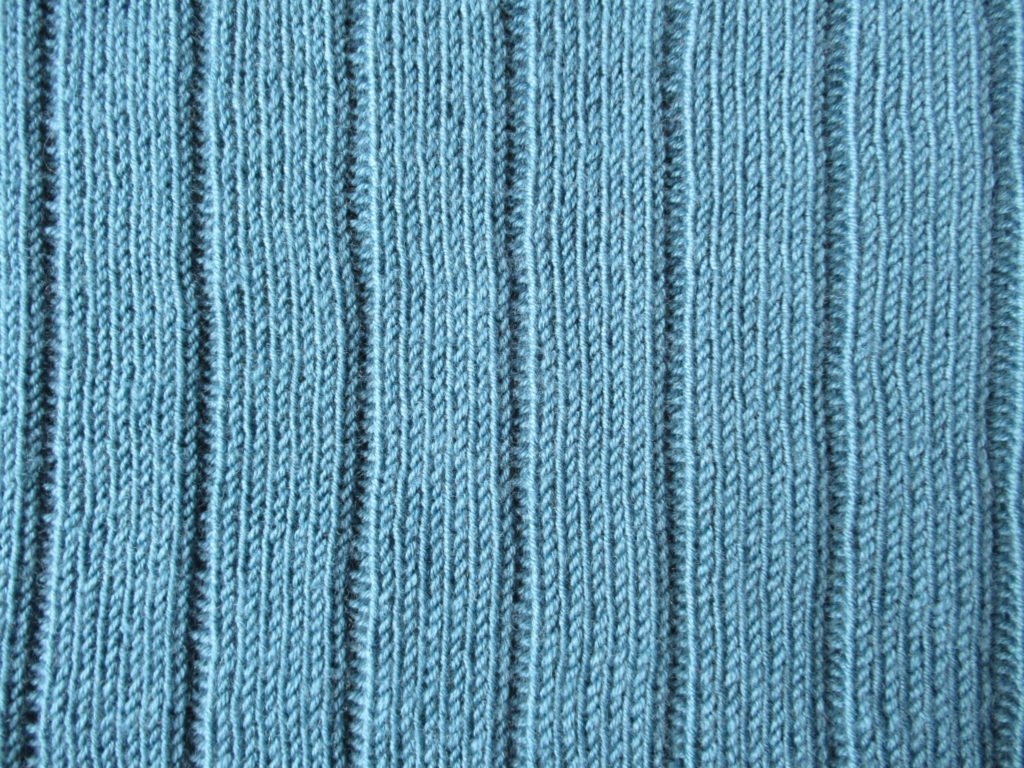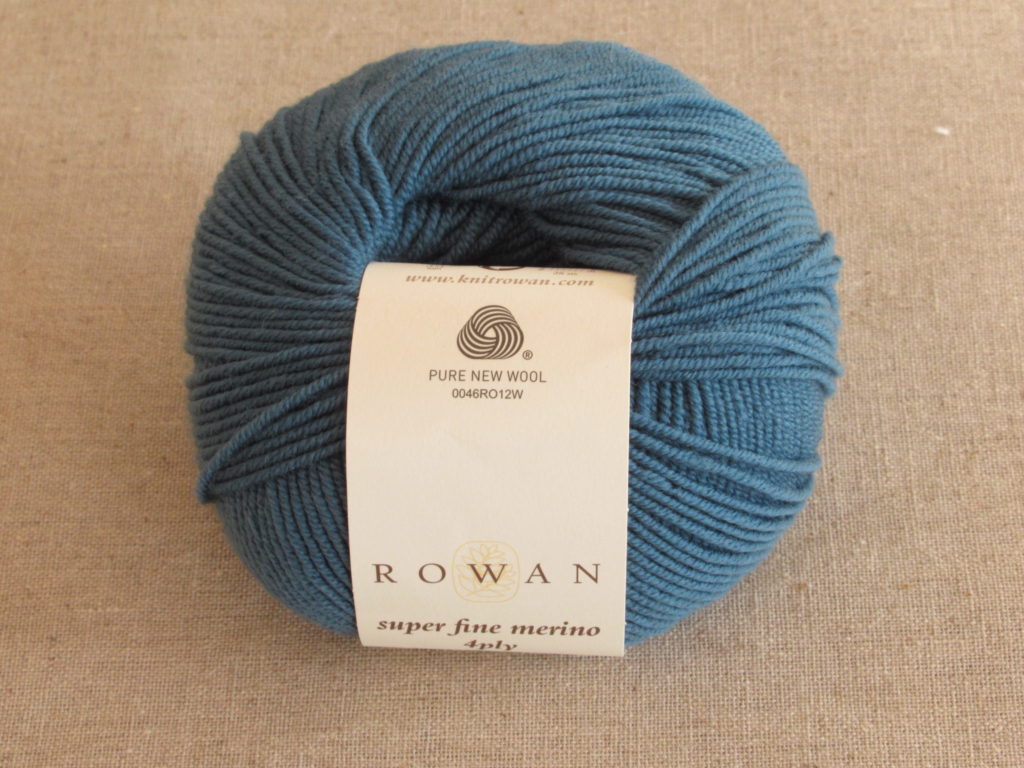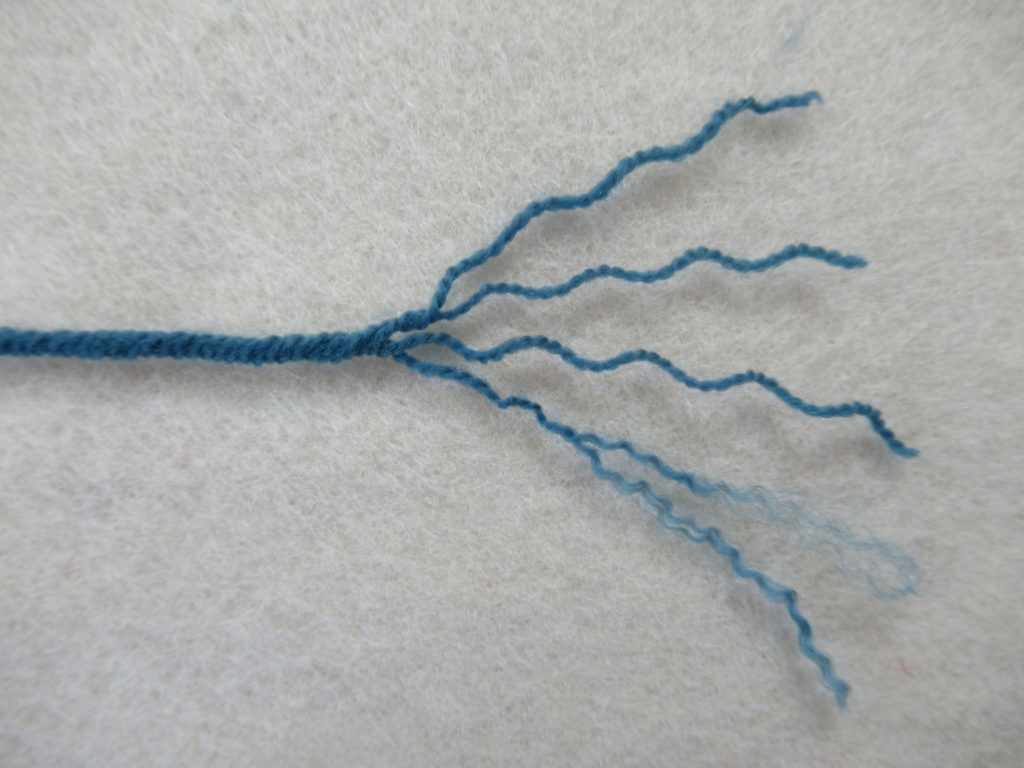Techniques
Making a Twisted Fringe
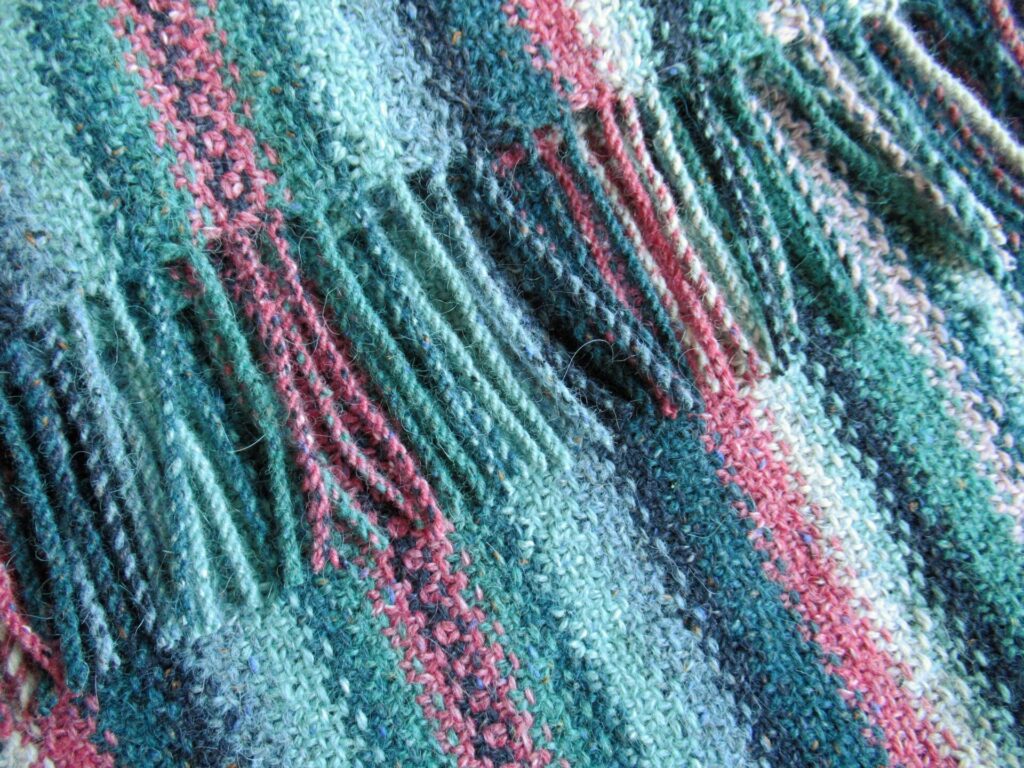
Hello!
We’ve had a lot of rather gloomy days here lately. I don’t mean gloomy because of the current coronavirus situation, although there is that too, but literally so gloomy that we need to keep the lights on all day.
We haven’t actually had a lot of rain. It’s just that on many days it’s been cloudy and grey.
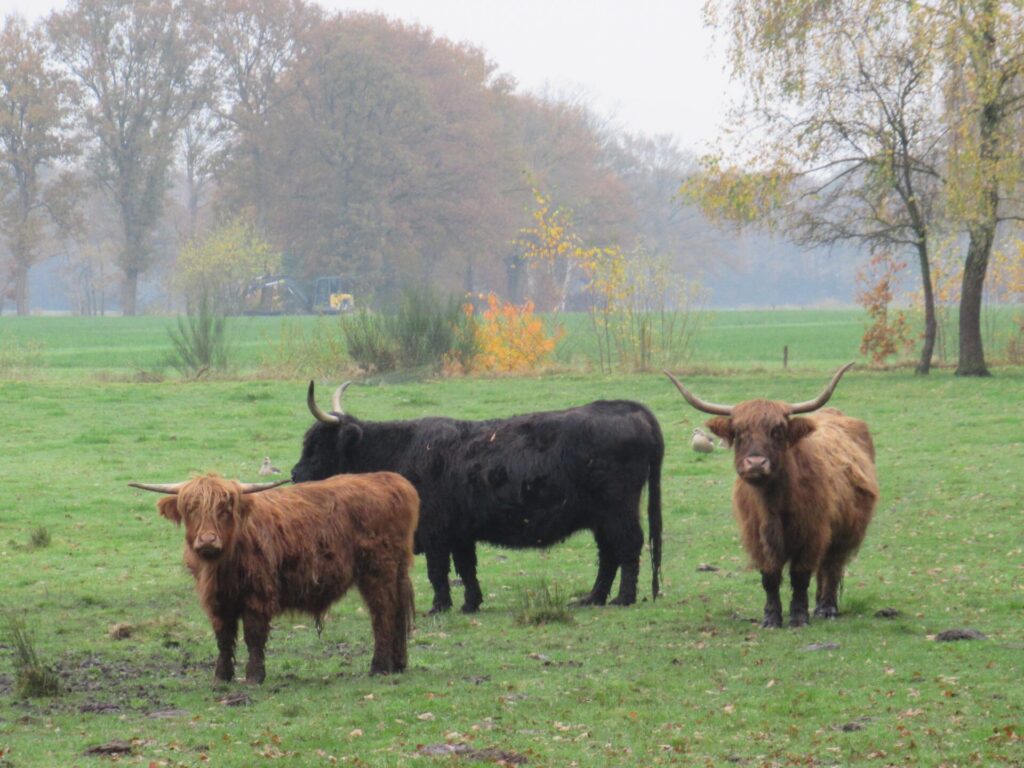
I don’t really mind, and even enjoy the quiet atmosphere of some of these days. For me, the problem is that there often isn’t enough light to take pictures indoors, while the table on the patio is too wet to spread my knitting out on.
But last Sunday suddenly the sun came out.

I quickly set to work, because I wanted to show you how to make a twisted fringe. I’d finished knitting my Striped Linen Stitch Wrap. In this project, every row starts and ends with a yarn tail. In the basic pattern these are knotted into a fringe, but a later adaptation has a twisted fringe and that was what I wanted to try.
The yarn I used was Rowan’s Felted Tweed, a blend of lightly felted wool, viscose and alpaca. Because I wasn’t sure if the technique would work for this combination of fibres, I tried it out on a swatch first, and yes, it worked! This is how it’s done step by step.
1) Pin the end of the wrap to blocking mats.
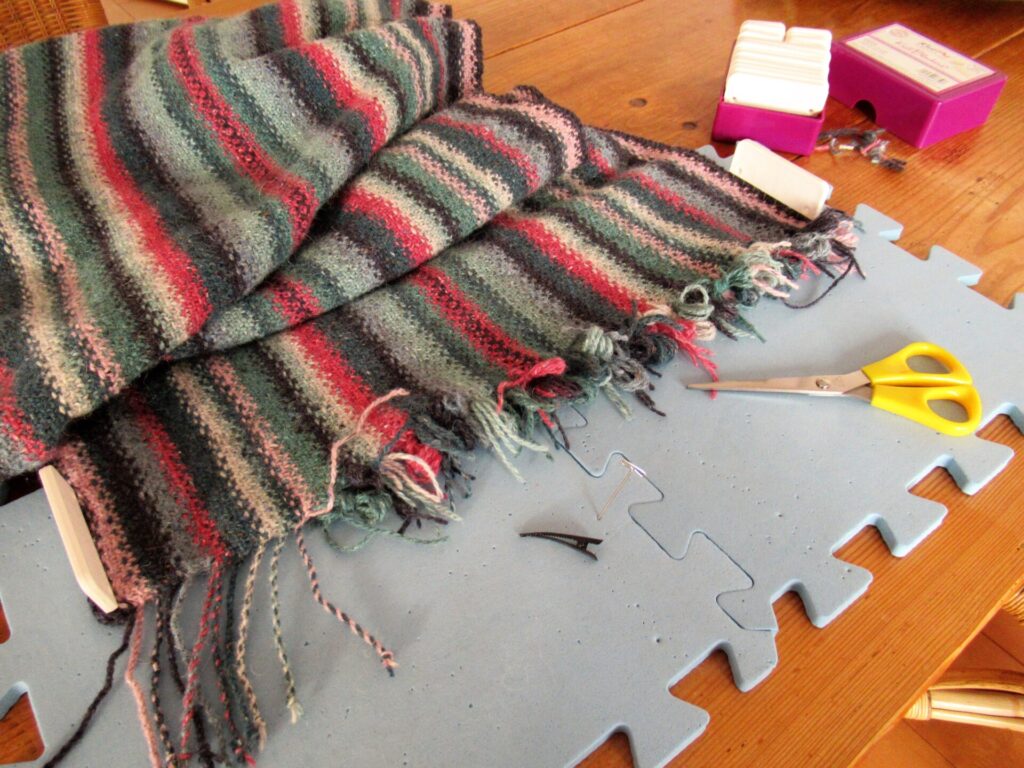
The yarn ends were tied into bundles during the knitting. These are now undone one by one.
While twisting the ends, they need to be kept in place. The pattern uses a binder clip for this, but as I didn’t have any of those, I used a hair clip and a T-pin.
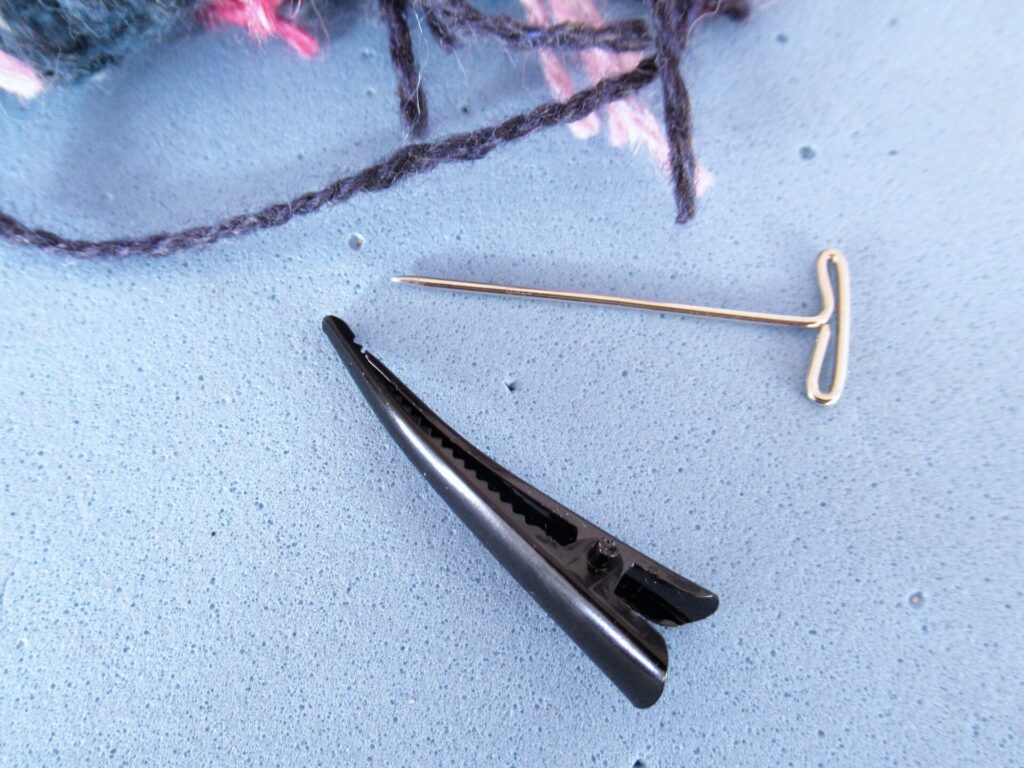
2) Undo a fringe bundle. Find the next 4 tails (they should be twisted in the order they were knitted).
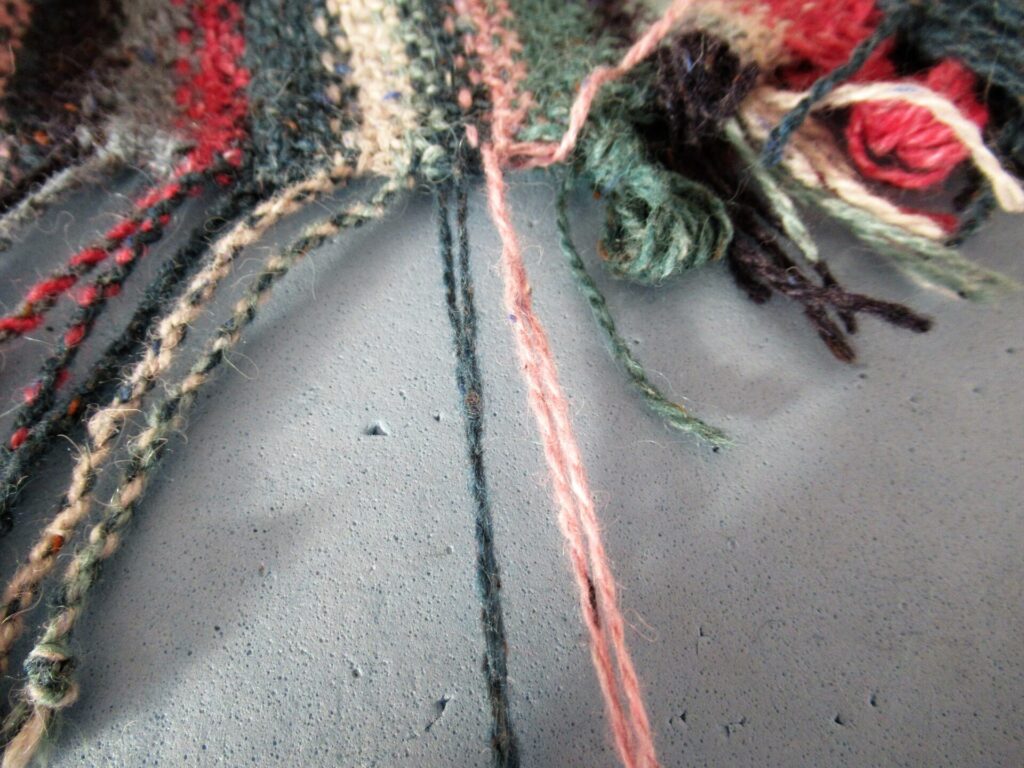
3) Twist the first 2 tails together in the same direction as the twist of the yarn (i.e. to the right). Continue until they are slightly overtwisted.
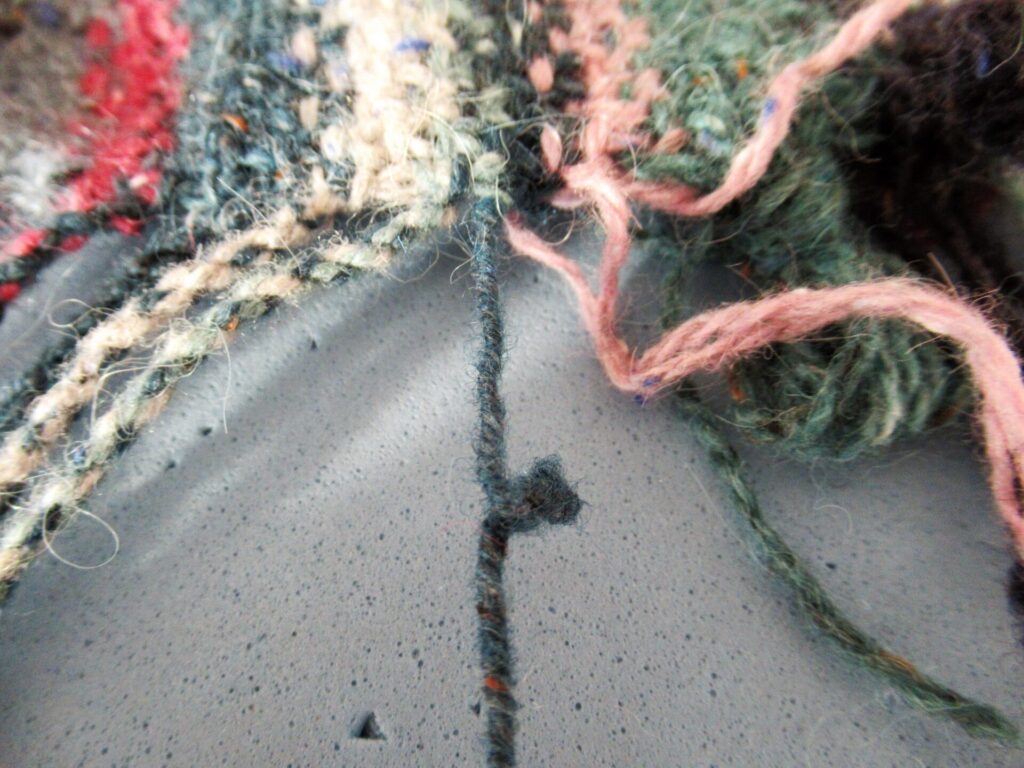
4) Secure with a clip and pin onto the blocking mat with a T-pin.
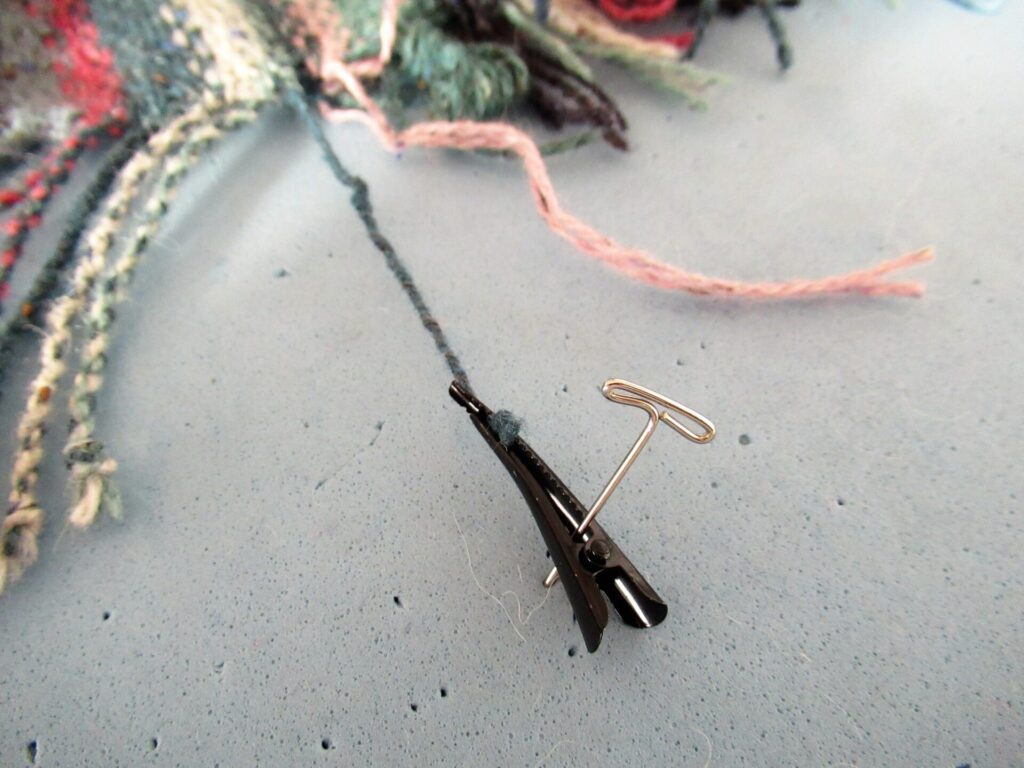
5) Twist the next 2 tails in the same way and hold. Unclip the first 2 twisted tails. Tie both sets of tails together with an overhand knot as close to the ends as possible and let go. They will now twist together. Smooth this twist by passing it between thumb and forefinger several times.
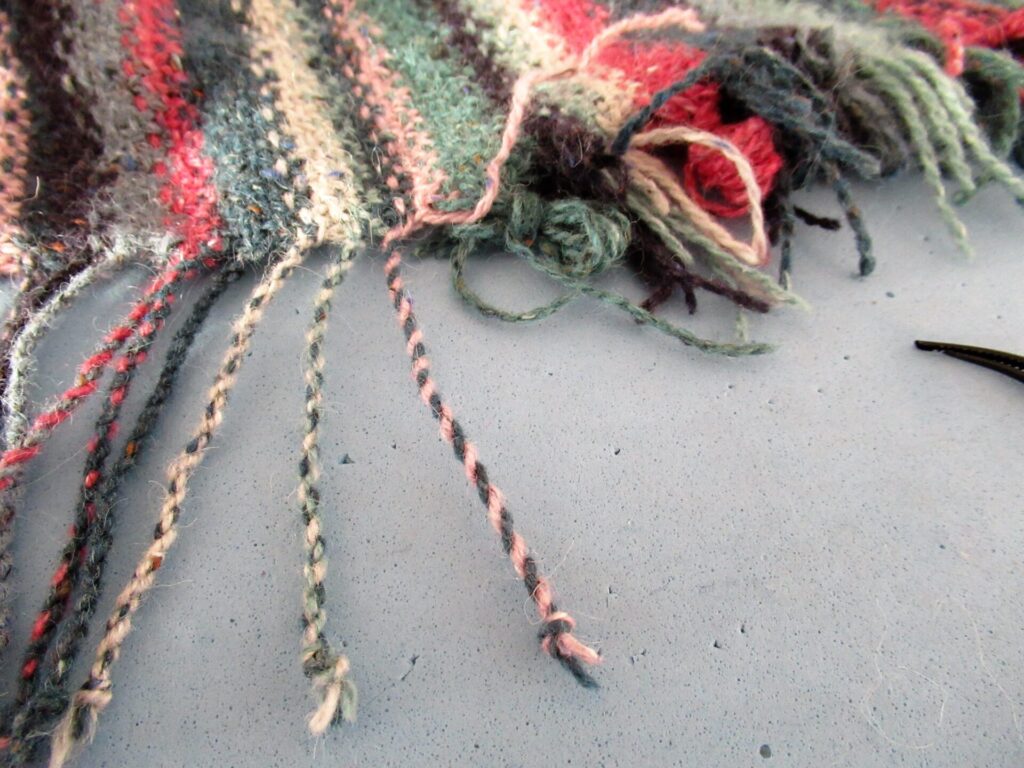
Continue like this until all yarn tails have been twisted. Then repeat steps 1-5 for the other end of the wrap. Remove the wrap from the blocking mats and place it on an ironing board. Comb out the ends so that they are straight and not crossing each other.
6) Spray the fringe with a plant mister.
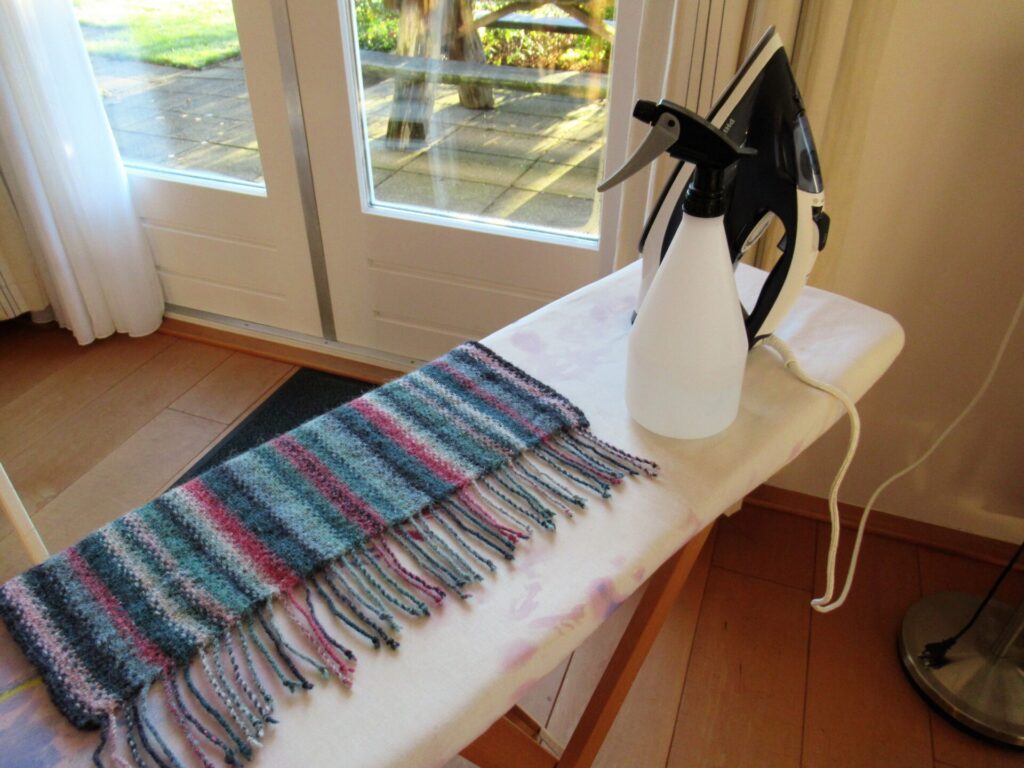
7) Cover it with a clean, moist tea towel. (Make sure it’s an old one that won’t give off any colour.)

8) Then, with the iron on the wool and steam setting, press the fringe with lots of STEAM.
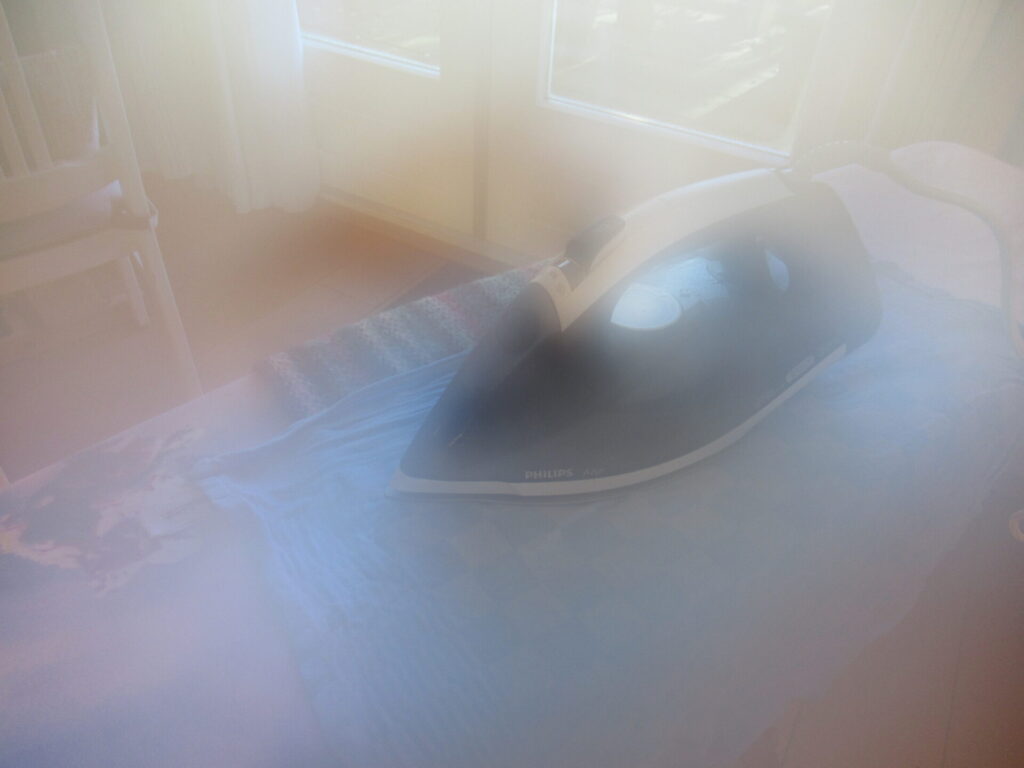
Repeat for the other end of the wrap and leave to dry thoroughly. The tails should now be slightly felted, preventing them from untwisting.
9) Place the wrap with one fringe on the end of a table top. Make sure that the wrap is placed straight and straighten out the tails. Then cut off the knots at the length of the shortest tail.
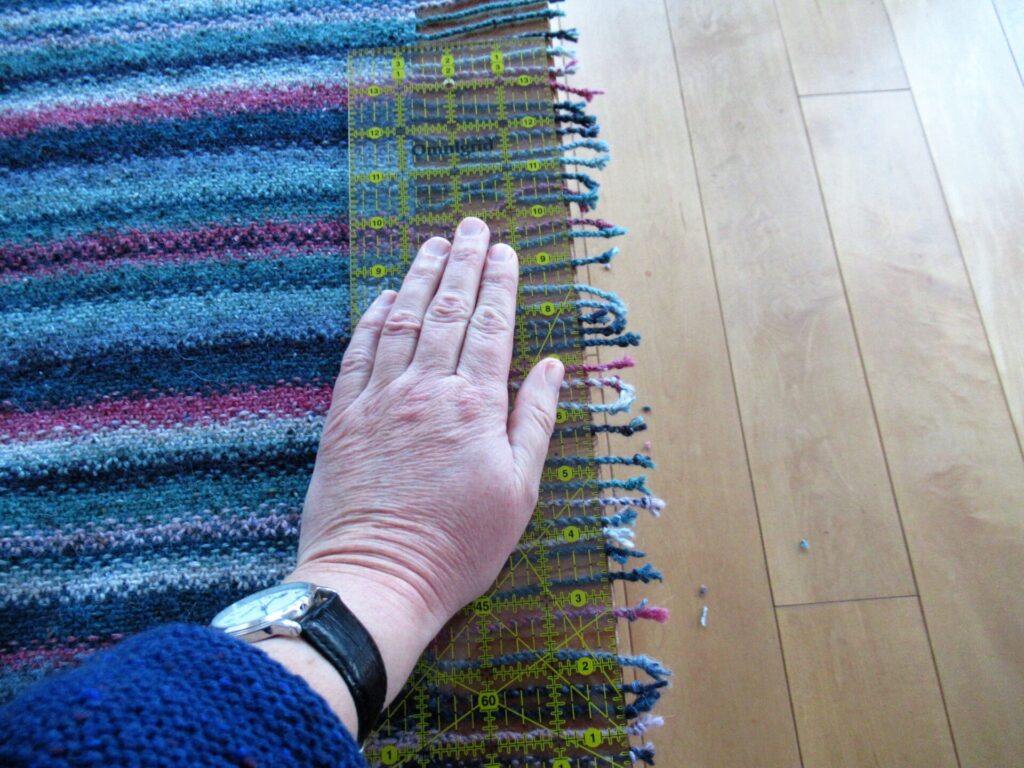
I used a quilting ruler to make sure I cut the tails off straight.
There, all done! This is a great finish for a scarf or wrap. It’s really lovely to see the colours combined differently in each tiny barber-pole tail.

I’m really happy with this wrap and at the same time slightly sad that it’s finished. Many of the things I knit are for others, but I’m keeping this one. I’ve loved working on it and will miss the soothing rhythm of slipping and knitting, slipping and knitting many, many stitches.
Now I’m hoping for colder weather so that I can wear it. It’s a strange autumn. The pelargoniums and lobelias in our outdoor pots are still flowering and it’s the end of November! Still, we’ve had some night frost…

… and more wintry weather is expected for this weekend.
In case you’d like to knit a wrap like this, the pattern is called Striped Linen Stitch Wrap & Scarf (there is also a smaller scarf version) and can be found here on the designer’s website and here on Ravelry. The free adaptation for the twisted fringe can be found here.
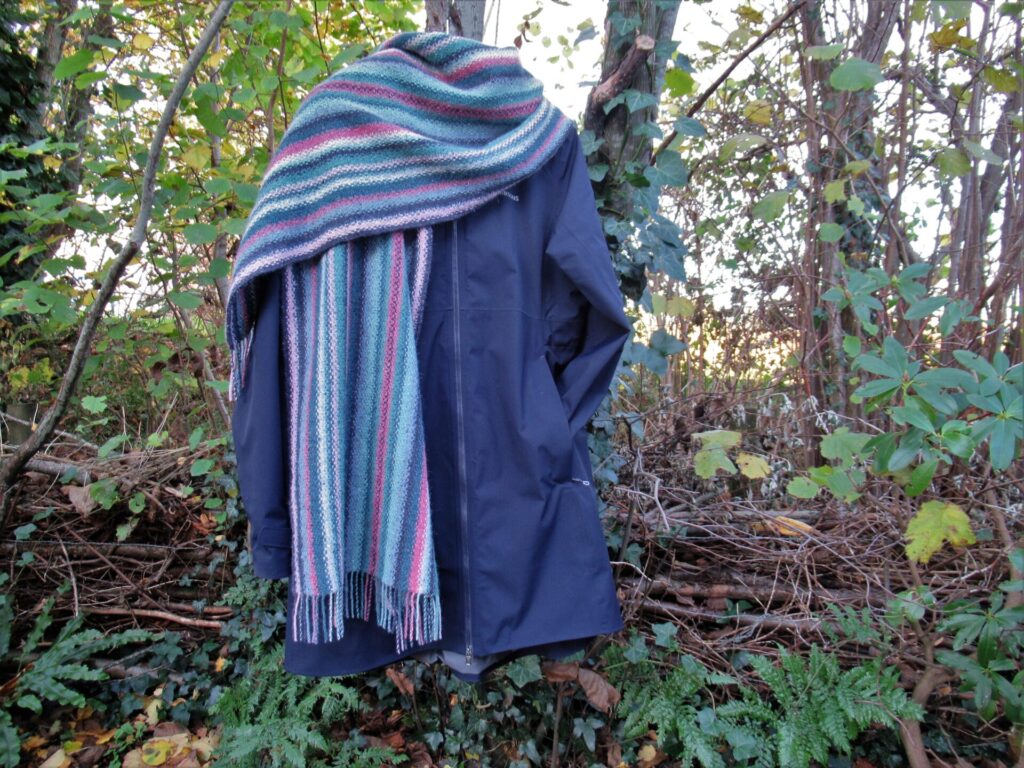
Well, I hope that just looking at this warm wrap with its colourful fringe has warmed and lifted your heart a little. Take care! xxx
Domino Knitting
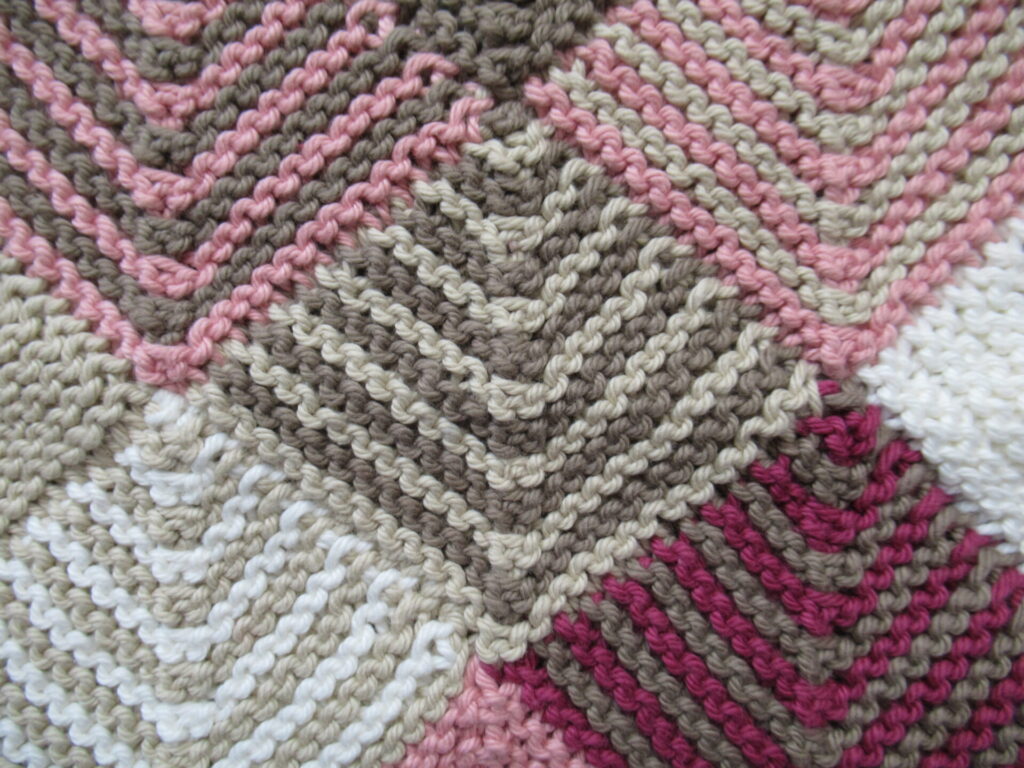
Hello!
After all the gadding about of the past few weeks, I think it’s time for some serious knitting again. I hope you’re up for it.
I first heard of domino knitting from a Danish woman I once met on a campsite in Rondane, Norway. She was sitting in front of her tent knitting back and forth on very short wooden needles. I was intrigued and asked her what she was making.
As is often the way with knitters, she was only too happy to talk about it. She told me that she was making a scarf for her sister-in-law from a pattern in the booklet Domino Strikk, by Danish designer Vivian Høxbro.
As soon as the booklet came out in English, in 2002, I bought it.
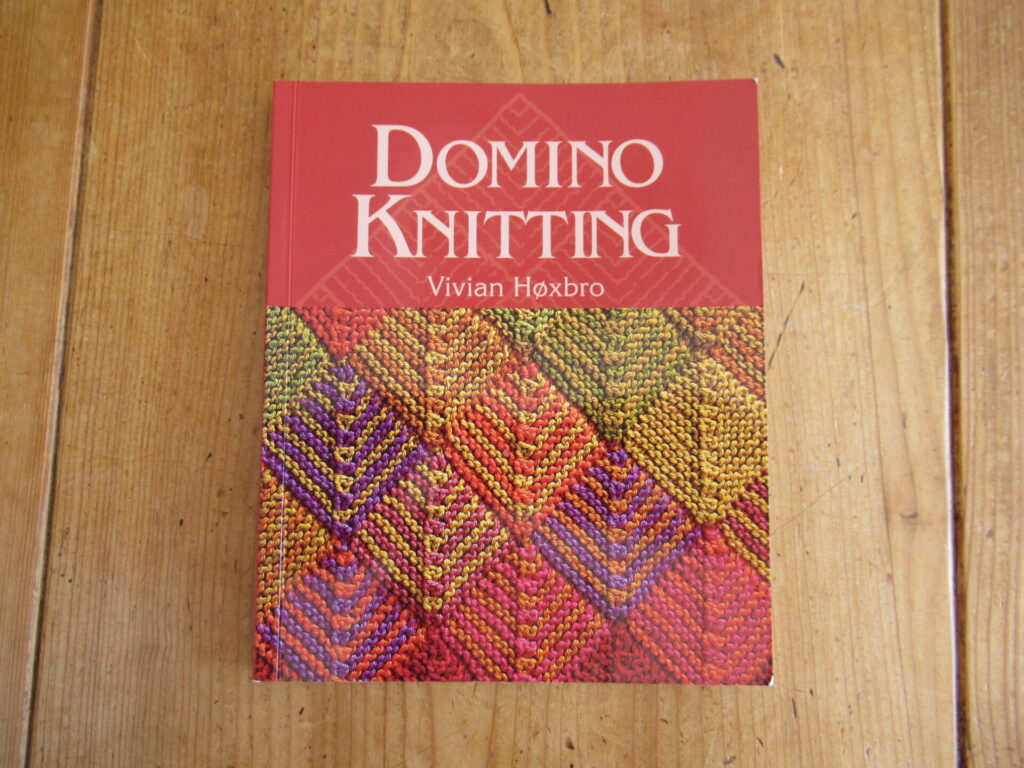
Høxbro didn’t invent the technique. In her foreword she tells us that it had been around for at least a century before she discovered it, only it wasn’t called domino knitting then. She was the one who made it popular, though.
The booklet clearly explains how domino knitting works with small modules, ‘knitted together while the work progresses, just as one “pieces” the tiles in dominoes’, and encourages us to try the techniques out by knitting potholders first.
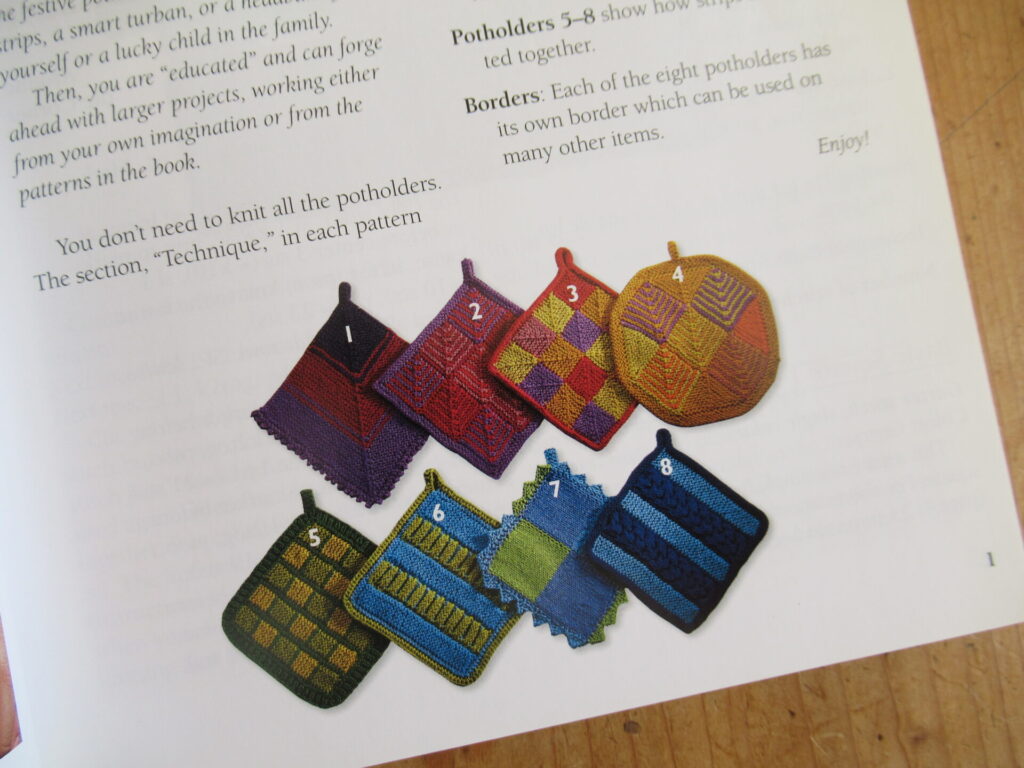
I made a couple of potholders to give domino knitting a try. They turned out too big and floppy to be useful. I have never used them, but kept them as a kind of curiosity. Here they are:
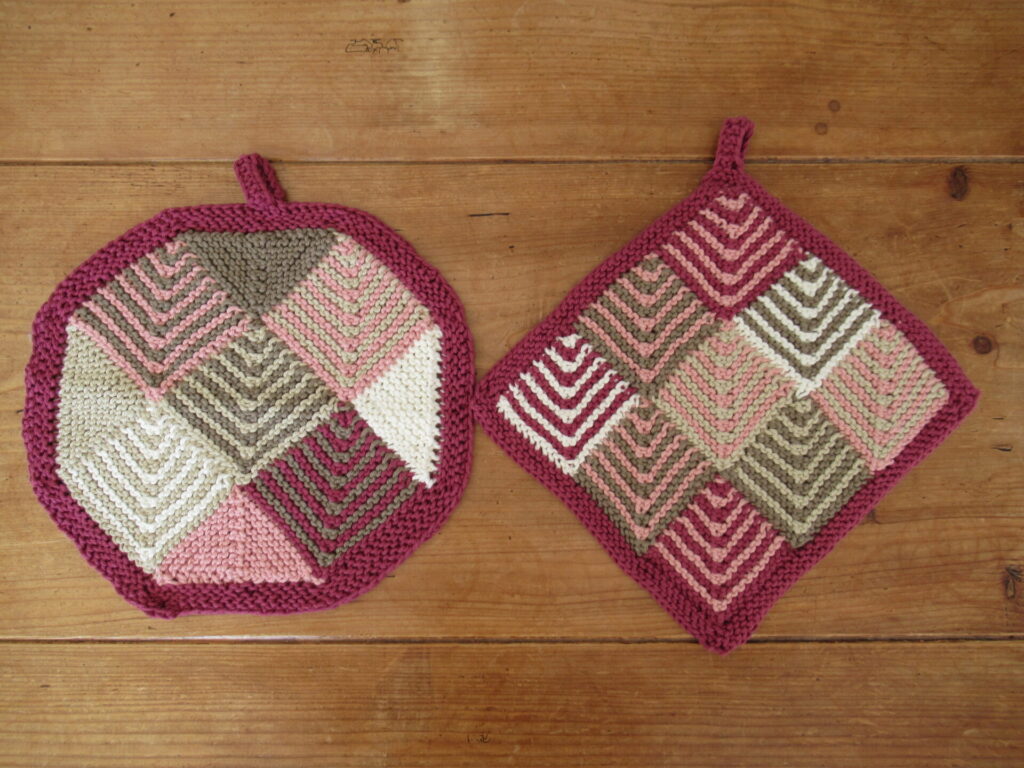
I left it at that, went on to knit other things, and more or less forgot about domino knitting. Until I started knitting a cardigan called Panel Debate last month.

As the name suggests, it is made up of panels. After finishing the first three panels, I suddenly thought, Why does this feel so familiar? Wait, this is potholder number five!
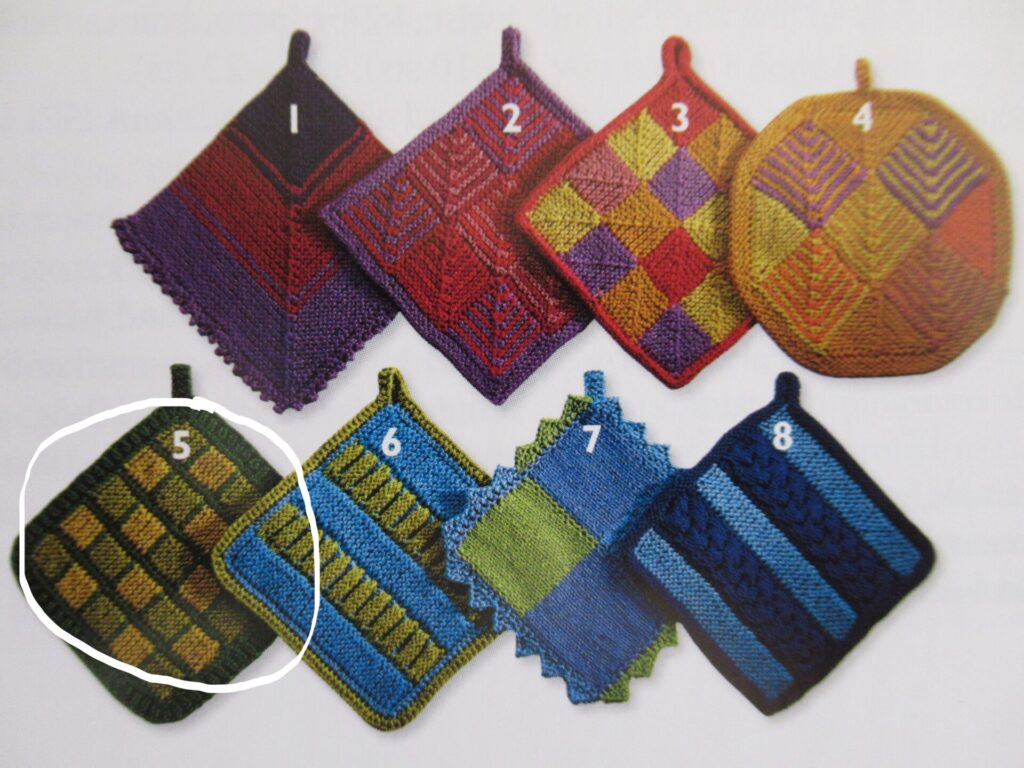
Well, it’s more like a super extended version of potholder #5, but it follows the same principle.
Narrow panels (1-3 below) are knit back and forth in alternating knit and purl ridges. Then stitches are picked up along the long sides for the next panel (4), knit lengthwise. The panel next to that is a narrow strip again, attached by knitting it together with the stitches of the previous panel every other row, and so on and so forth.
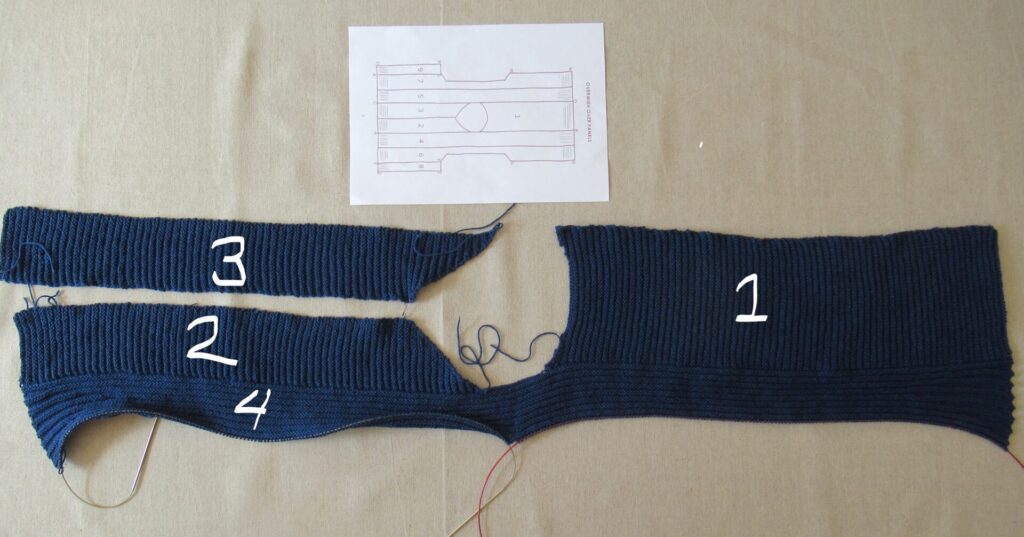
Calling Panel Debate an extended potholder doesn’t do it justice at all, of course. What with the knitted-on sleeves and I-cord finishing it is much more than that. The designer has also added lovely short-row fans at the bottom of fronts and back.
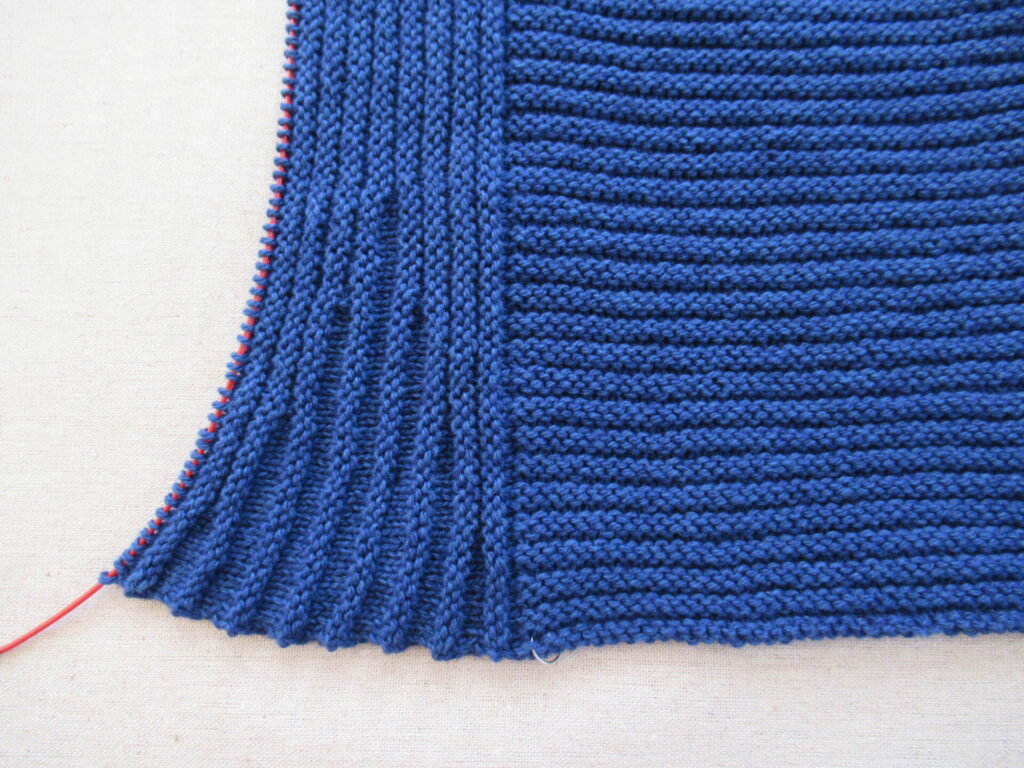
It’s a lot of stitches on 2.75 mm needles, and after I’d knit the swatches I wondered if this cardigan really was a good idea and if I’d ever finish it. But because of the modular technique, Panel Debate stays interesting and makes me want to keep on knitting.
There are heaps more domino-knit type of garment patterns around. Many of them use variations on the mitred squares of my potholders.
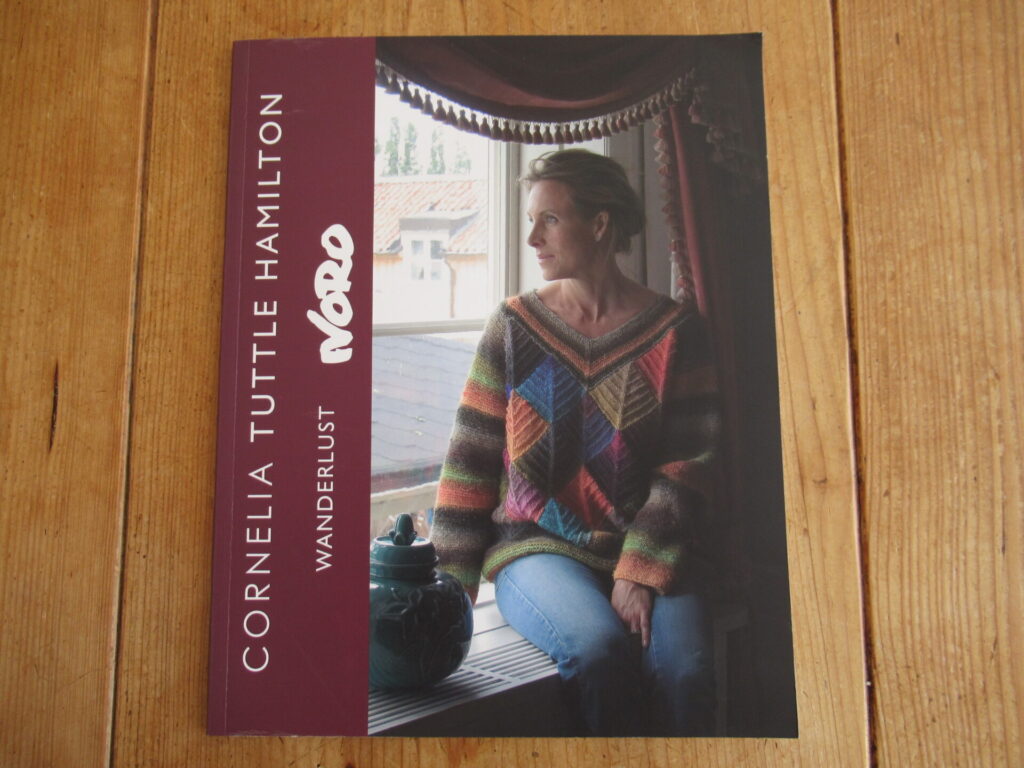
It’s a technique particularly suitable for colour-shift yarns like Noro. I really love the way this sweater makes use of the colours.
As Høxbro warns us in her foreword, ‘Domino knitting is addictive.’ Why did it take me so long to get hooked?
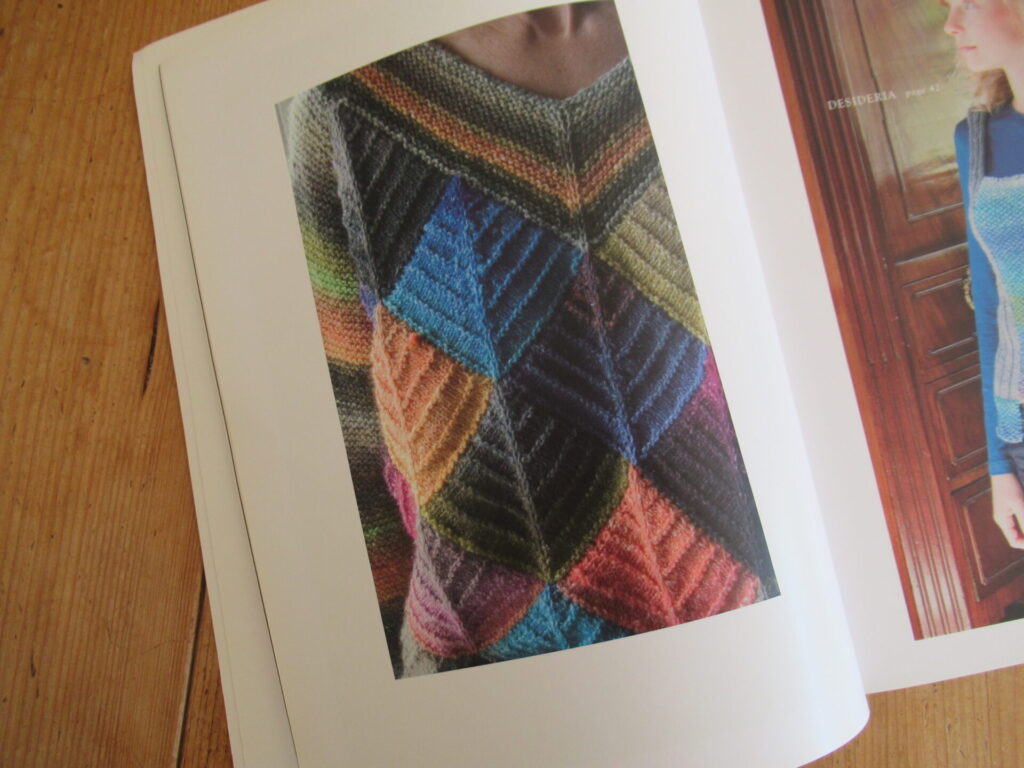
Knitting Sideways
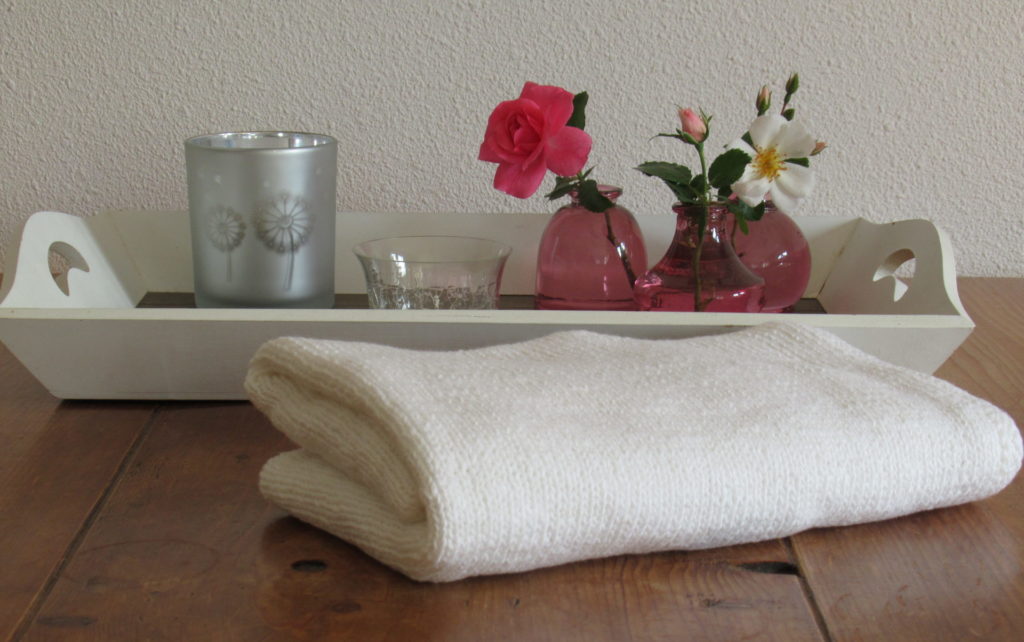
Mid-September. The mornings are starting to feel chilly and the smell of autumn is in the air. In the garden there are still some roses to be picked and the autumn anemones are flowering profusely. It’s the time of year to start thinking of warm and woolly knits. But first it’s time to finish some summer projects.
My ‘big’ summer knitting project was an oversized T-shirt, from a pattern called Sideways Tee, designed by Churchmouse. I’m not much of a summer knitter – I prefer woolen yarns and cosy socks, sweaters and shawls. But after a very hot spell early in the season, I realized that I needed something cool and summery to knit or I wouldn’t be able to knit at all on hot days.
Now I’d like to show you what I made and how I set about it. I like looking over other makers’ shoulders and hope that what I’m doing will be interesting and useful to others too.
Before I start knitting a garment, I always swatch. I don’t swatch for socks, and I don’t always swatch for shawls and scarves. But for garments it makes all the difference between success and failure.

This time it was a good thing I did, too. For the first swatch, I used the recommended needle size (4.5 mm) but didn’t get the right gauge. So I went down a size (to 4.0 mm), knit another swatch and, yay, the gauge was correct. I washed both swatches to make sure the knitting didn’t shrink or grow, but it was fine, so I could start knitting.
The Sideways Tee has an interesting construction. Both front and back are started from a provisional cast-on in the middle, and are knit outward to the sides. It isn’t called Sideways Tee for nothing.
In this case it isn’t your usual ‘crochet a chain and pick up stitches from the bumps.’ It’s a more sophisticated provisional cast-on, that is crocheted over the knitting needle.
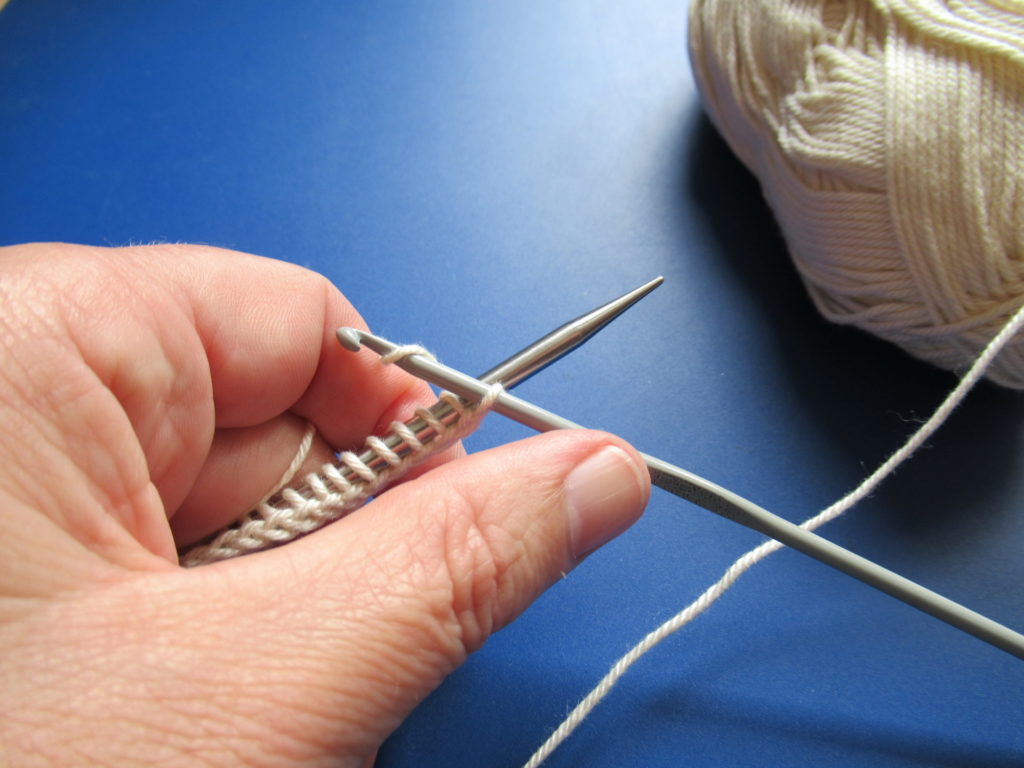
I’ve used this technique before, and think the result is much better than with the crocheted chain technique.
At first sight this Tee looks very simple. But the only thing that is simple about it, is the stitch pattern – a simple stocking stitch. Other than that it has many interesting features, like sloping shoulders, side shaping and short rows. The 8 pages of the pattern are packed with instructions, diagrams and special techniques.
I could easily lose my way leafing back and forth through all these pages, and took several measures to prevent confusion.
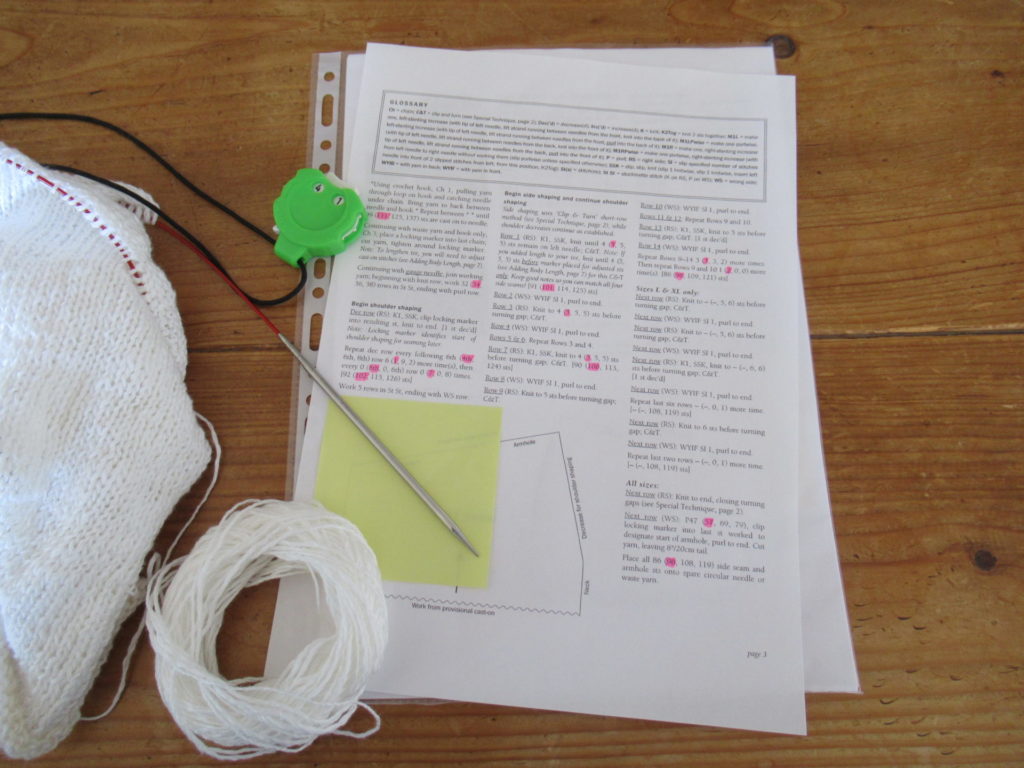
To start with I marked everything related to my size with a pink highlighter (I’ve discovered that yellow becomes invisible in lamp light). I used a row counter (the bright green thing) as well as sticky notes to keep track of where I was in the pattern.
The first half of the back ended with some short rows, done with a special technique called C&T (Clip and Turn) by the designer. It involves lots of locking markers, as you can see here:
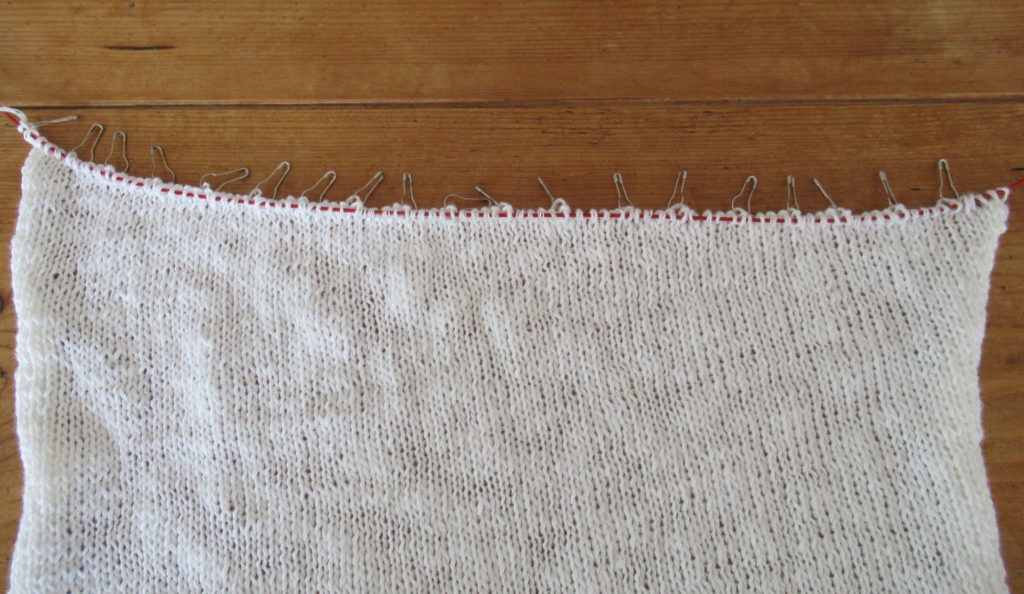
I used some very fine metal locking markers for this. They were a gift from a friend and I really like them, because they don’t distort the knitted fabric like the thicker plastic ones can do with this technique. (I did use plastic ones to indicate armholes, neckline etc.) In the final row, all the gaps caused by the short rows are closed and the stitches are placed onto a piece of waste yarn.
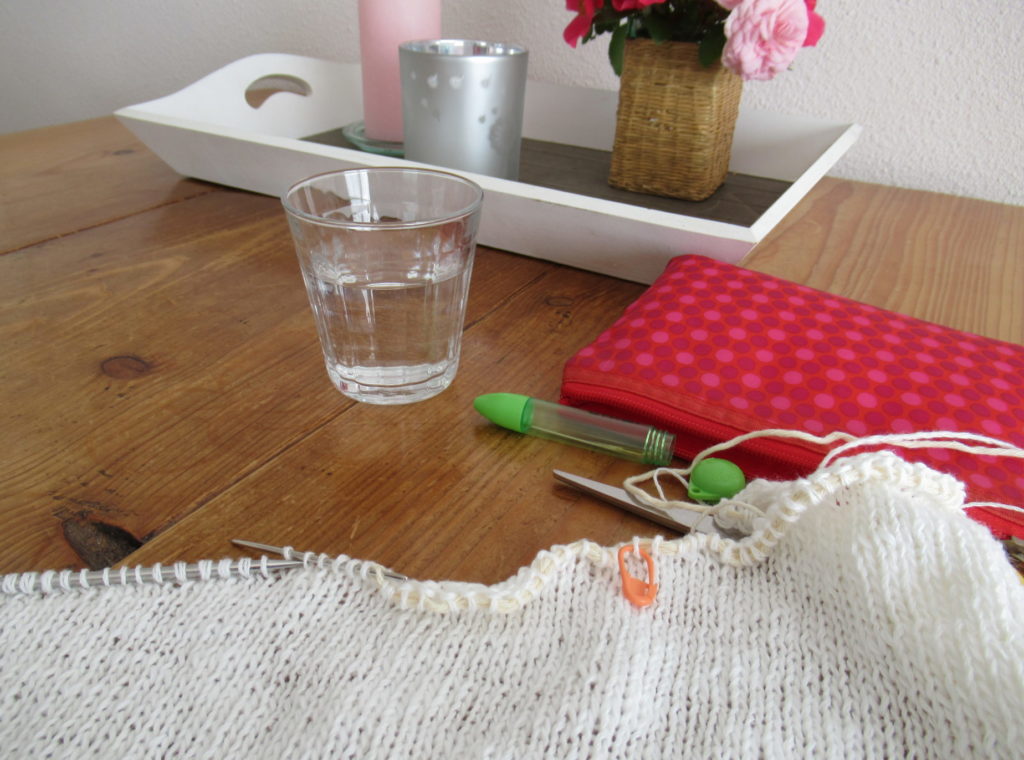
Then the stitches from the provisional cast-on in the middle are picked up, while the waste yarn used for the cast-on is removed.

This technique works very well. I think it’s rather daring to start like this, because you could easily get a wonky row right in the middle of the front and back that would spoil the entire garment. But I can’t see where I picked up the stitches – can you?
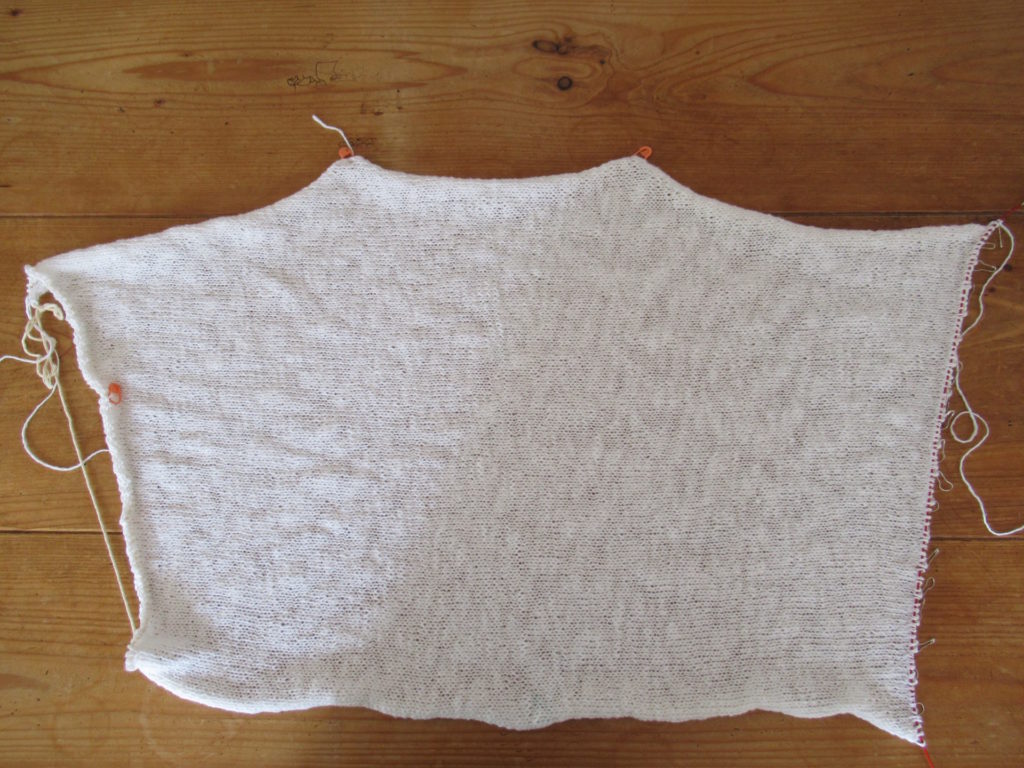
After finishing back and front it was time to start seaming the shoulders. At this point my Tee looked like this:
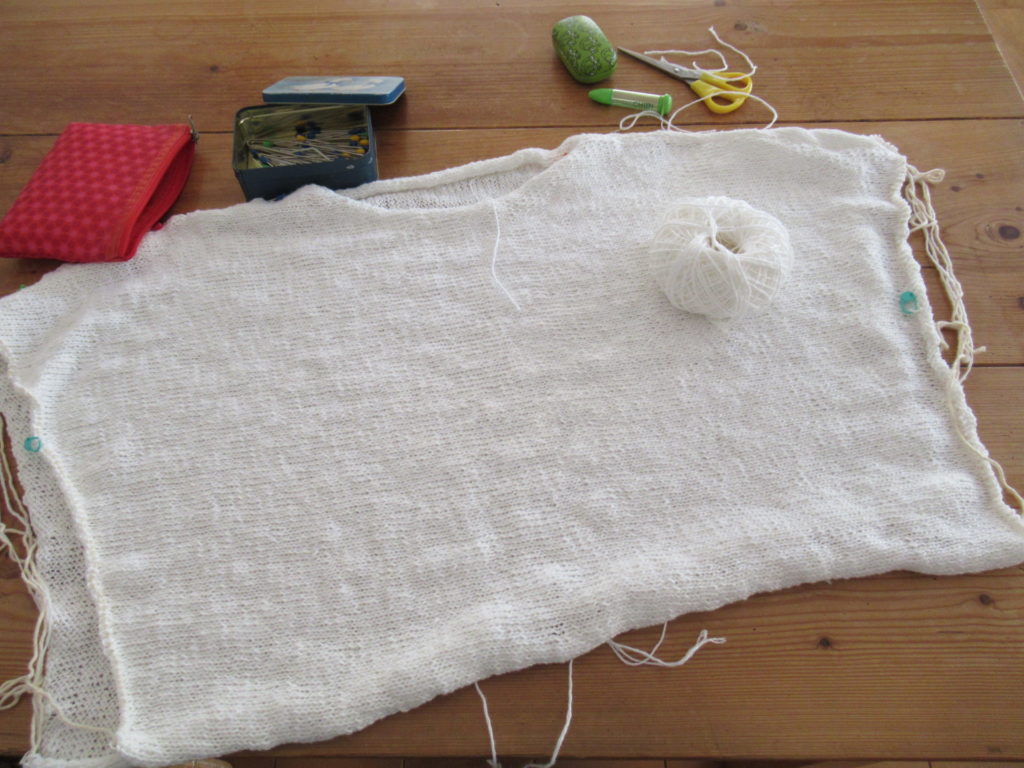
For me, this was the absolute low point of this project. It looked terrible, like some kind of frumpy, strangely shaped, too short poncho. If it wasn’t for this blog, I could easily have thrown it into a corner never to look at it again. But I’d planned to show the finished T-shirt here, so I persevered.
After closing all the seams and knitting on the edgings, I washed the shirt and threw it into the dryer until almost dry before blocking it.
When it was on my blocking mats I saw that it was going to be okay after all.
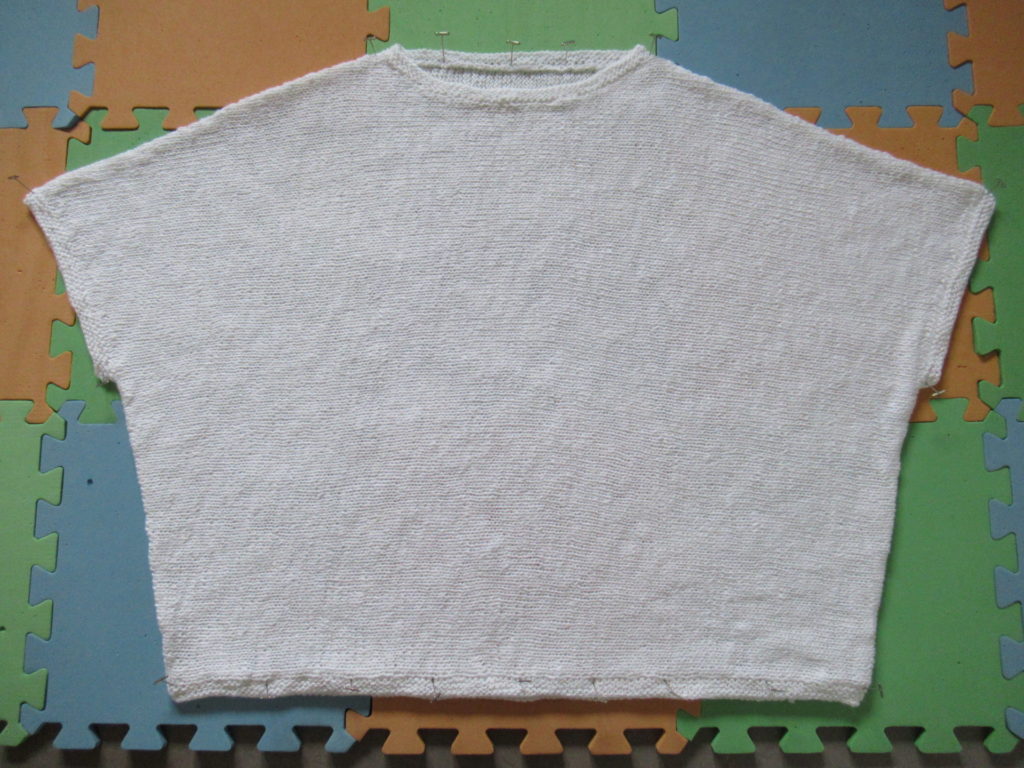
The size was exactly as it should be according to the pattern. I was really happy with that. I only pinned the shirt into place with a few T-pins. After drying, I steam pressed it for an extra neat finish.
And this is what my Sideways Tee looks like when worn:
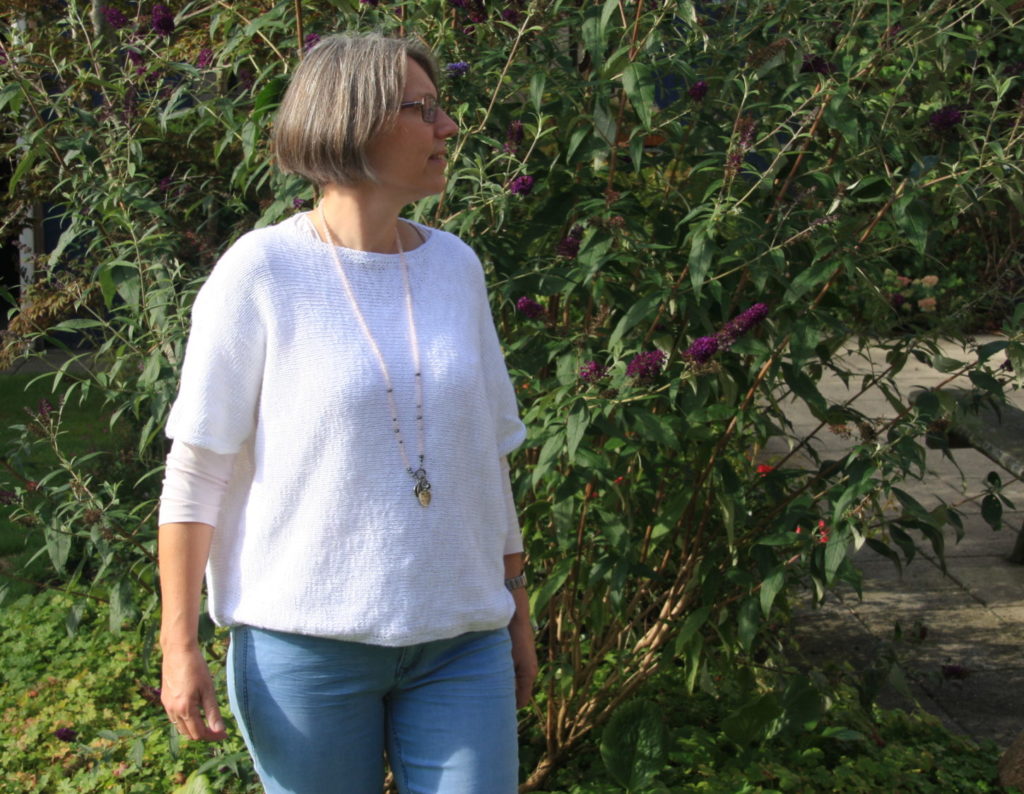
It’s a very different type of garment from what I usually choose. Usually I choose more fitted, A-line shaped garments. So this was a bit of a gamble, but all in all I’m happy with it.
The only thing I’m not too happy about, is the neck edging. There is a row of rather loose stitches along the front neck.

I don’t know what I could have done differently. Maybe it’s because the yarn has no bounce and doesn’t fill up the holes, or maybe it’s because the sideways knit stitches stretch too much. I don’t know. It’s just a small detail, however – the rest is fine.
I like the drape and feel of the knitted fabric. I think it’s a flattering shape. And I like the sloping shoulders and fit of the ‘sleeves’ (which are, basically, just armholes with an edging).
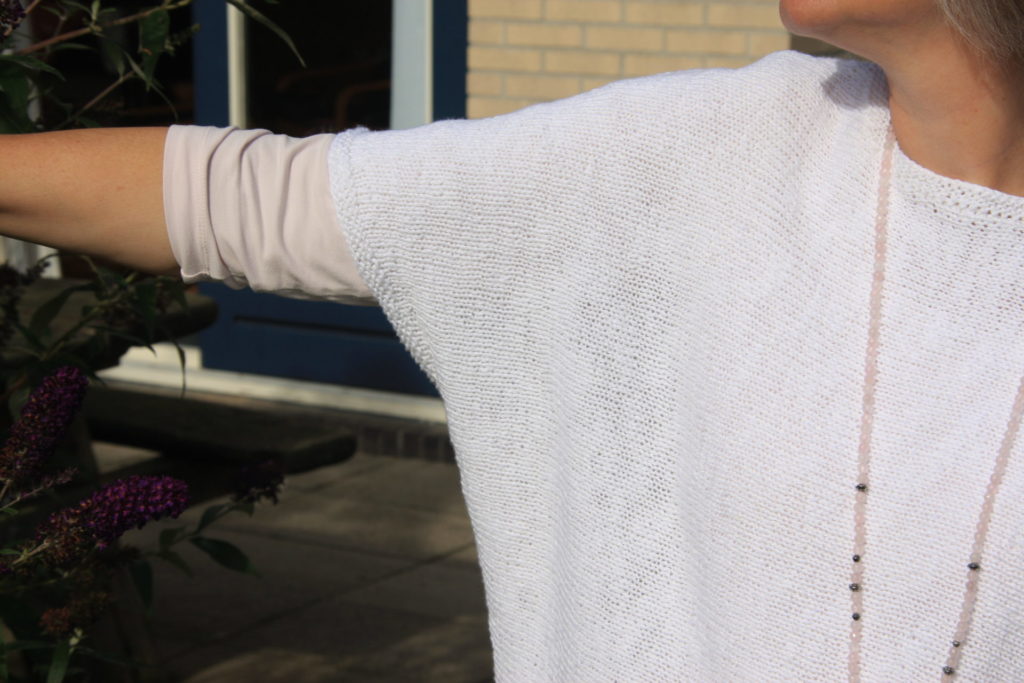
Finally, here’s a shot of the back. It’s definitely oversized, but far from shapeless.
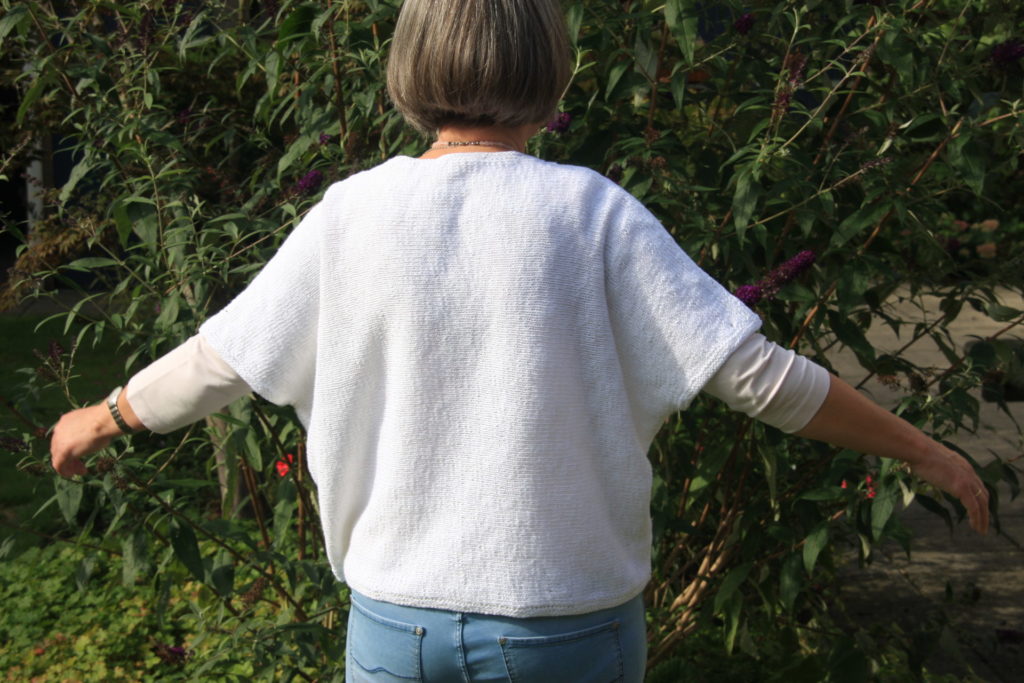
Well, I finished that nicely in time for summer, didn’t I? (Summer 2020, that is.)
Oh, and then there’s the yarn, of course. I almost forgot to mention it, but it’s one of the most important elements. It can make or break a knitting project.
I chose Juniper Moon Farm ‘Zooey’ for my Sideways Tee because it felt cool and crisp, and because it happened to be available from a local yarn shop. And I chose white because it’s a nice and summery colour that goes well with jeans.
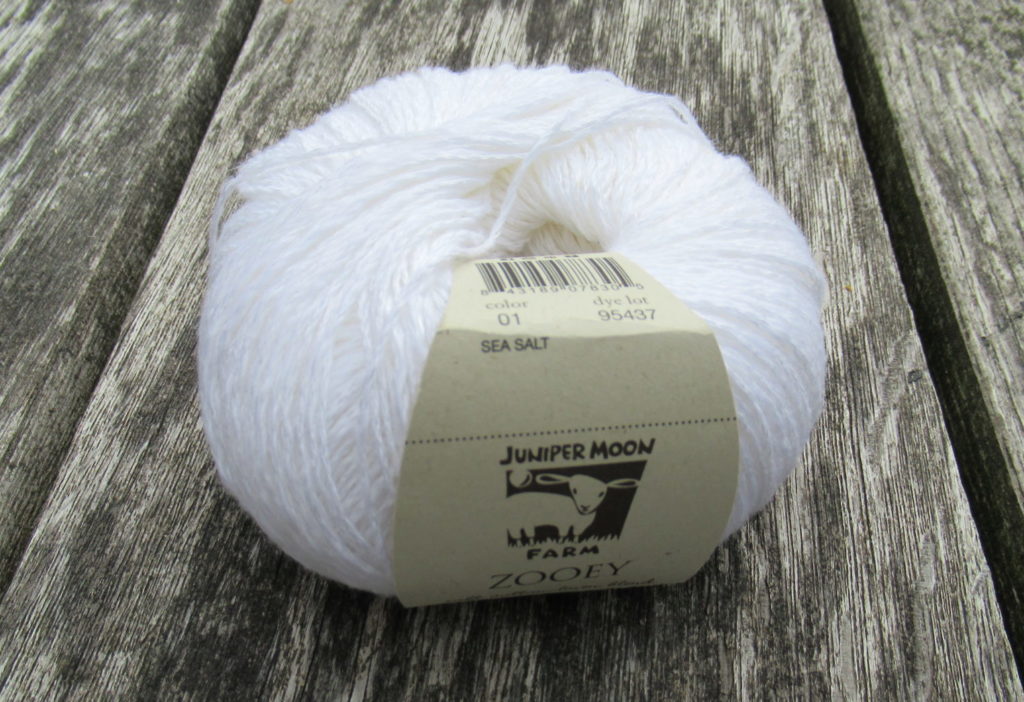
Zooey is a 60% cotton, 40% linen blend with thicker and thinner parts. It is loosely twined and, because of that, very splitty. It is easy to miss one of the strands, resulting in a thin spot in the knitted fabric, or to mistake one stitch for two and accidentally increase a stitch. I’m speaking from experience. Both have happened to me and I’ve had to frog quite a bit to fix it.
After a while I got used to the yarn, and developed a knitting technique that prevented me from sticking the needle into stitches by pushing the strands together with my index finger. This is definitely not a yarn for mindless knitting. Having said that, it gives a very nice fabric – drapey with a lovely irregular structure.
Well, that’s the story about my Sideways Tee. If you’d like to make one too, I can recommend it. It’s a really enjoyable and interesting knit. Looking ahead to autumn, I think it will work very well in a cosy woolen yarn, too.
To end today’s blog post, in style with the focus on white, here’s a picture of our beautiful autumn-flowering Japanese anemones ‘Honorine Jobert’.
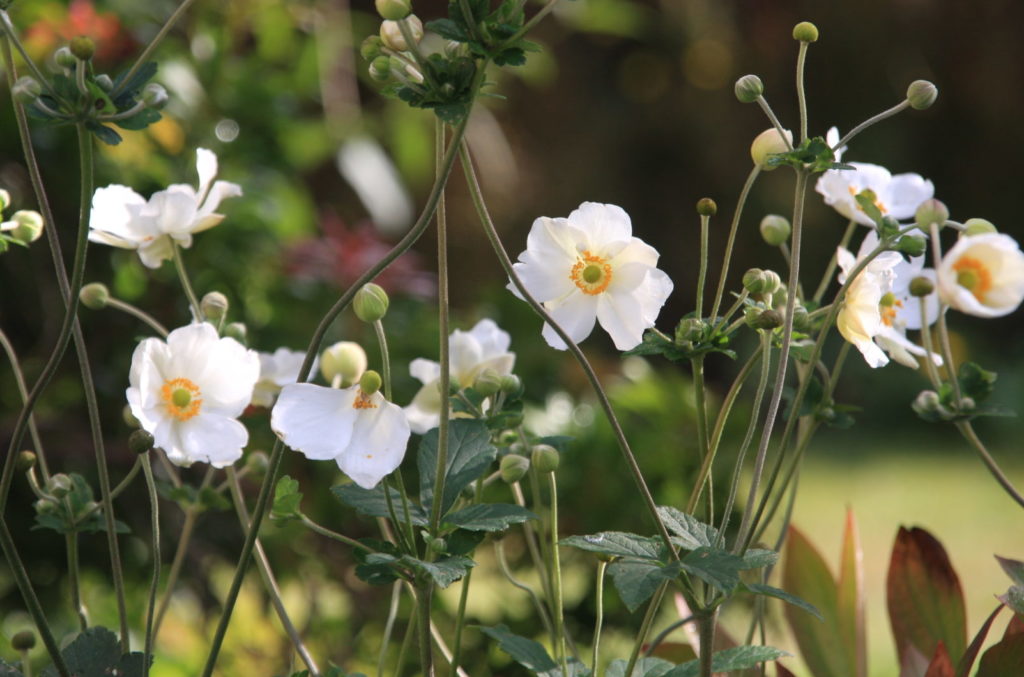
Note: This post isn’t sponsored in any way. I only mentioned the pattern store and yarn brand because I think it’s essential information.
Frogging

I’ve been knitting for over fifty years and I knit almost every single day, so I think I can safely say that I’m an experienced knitter. I can’t say that everything always goes swimmingly, though. After all those years, I still run into obstacles, and I still often have to frog things.
For a long time, I was baffled by the verb ‘to frog’ for unravelling knitting. It wasn’t in any of my dictionaries in this sense of the word. I just didn’t get why people called it frogging. Until Adrienne Martini explained it to me, on page 50 of her hilarious book Sweater Quest: My year of knitting dangerously:
‘Frogging, which doesn’t involve amphibians, means pulling out large swaths of knitting at one go. You rip it. If you don’t get the association, say it out loud.’
Rip it, rip it. Ah, I finally got it! Well, I’m a frequent frogger. Take a seemingly simple shawl like Stay Soft.
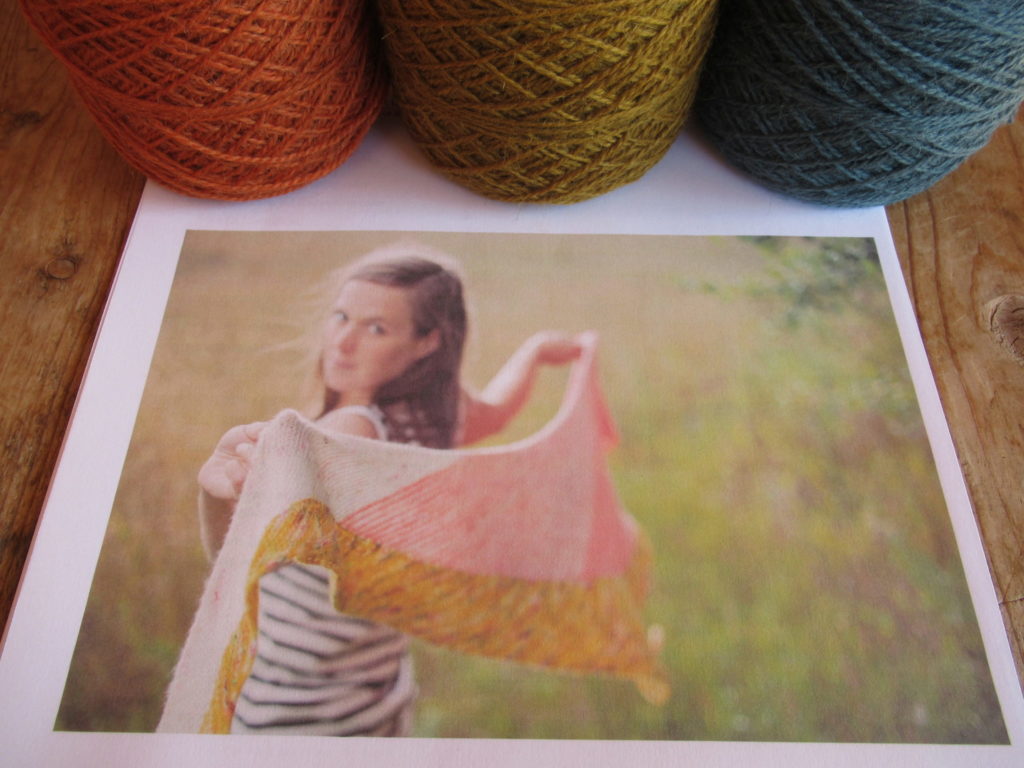
I started out cheerfully, casting on a small number of stitches, gradually increasing along one edge of the garter stitch rows. Everything was plain and clear in the pattern. No need to frog anything this time, right? Wrong.
Because I had a finer yarn and less yardage than the amount specified in the pattern, I’d decided to use a smaller needle size to be on the safe side. But when I’d finished both the yellow and the striped section (i.e. after knitting about one third of the entire shawl)…
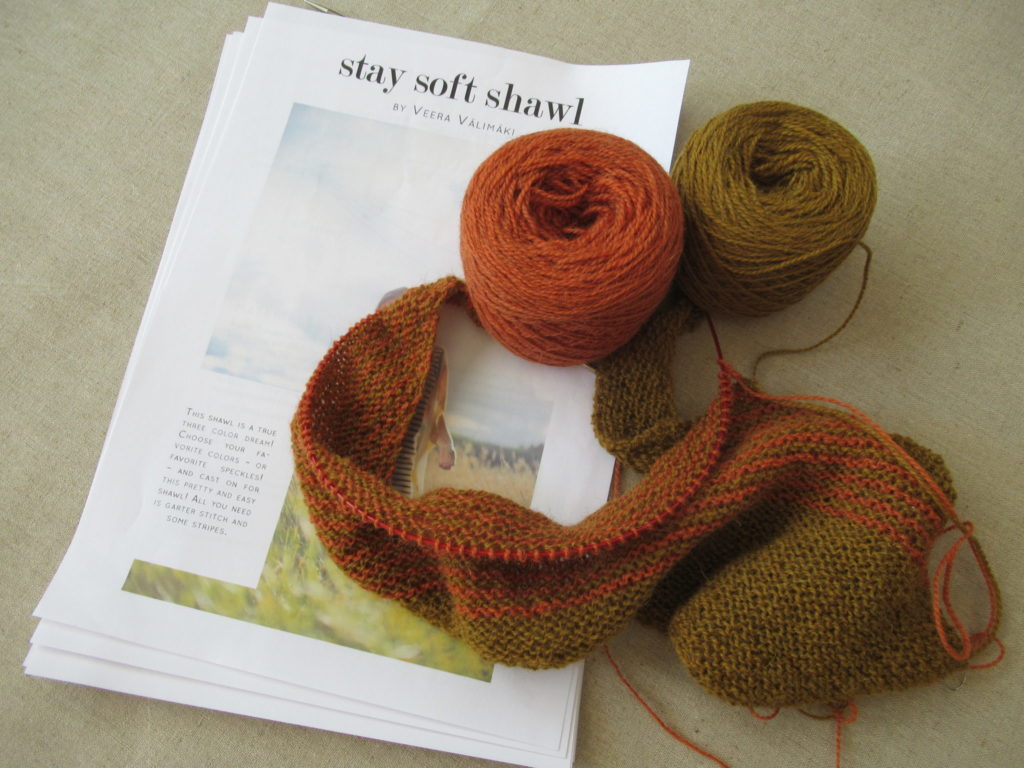
… I had an awful lot of the first yarn colour left over – almost two-thirds of the total amount. It would be a shame to waste all that yarn. Besides, the fabric didn’t feel quite right, and it looked as if the final shawl would end up rather small if I went on like this.
So, I frogged everything I’d knit so far and started afresh with the needle size specified in the pattern.
The second time around the fabric looked and felt better. I quickly re-knit the yellow and the striped sections. On the orange section I ran out of yarn after I’d knit 16 rows less than the pattern indicated, but I wasn’t really worried by that.
By that time the shawl already had quite a good size (but rather a strange shape):
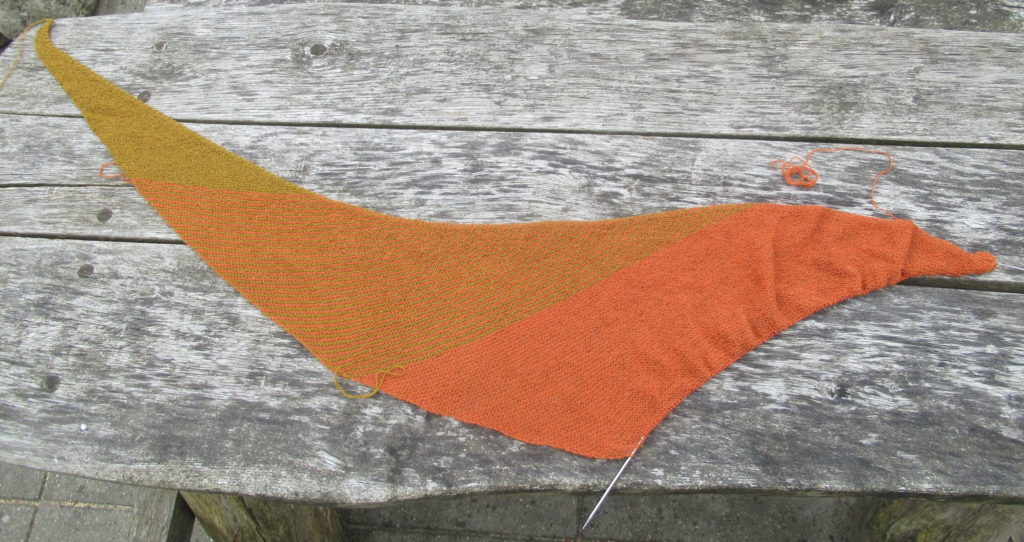
Now it was time to pick up stitches for the third colour. I read through the instructions: ‘pick up and knit 5 stitches starting from the cast-on corner of the shawl.’ Hmmm, where exactly? And how?
This pattern has been knit by many people before, so I thought I’d take a look at other projects on Ravelry, to see how they had done it. I read that others had scratched their heads, too, at this point. Many of them somehow found the solution, and some people even made notes of what they’d done, but I was still a bit confused.
So I tried something, frogged it, tried again, frogged again, until I was happy with the result:
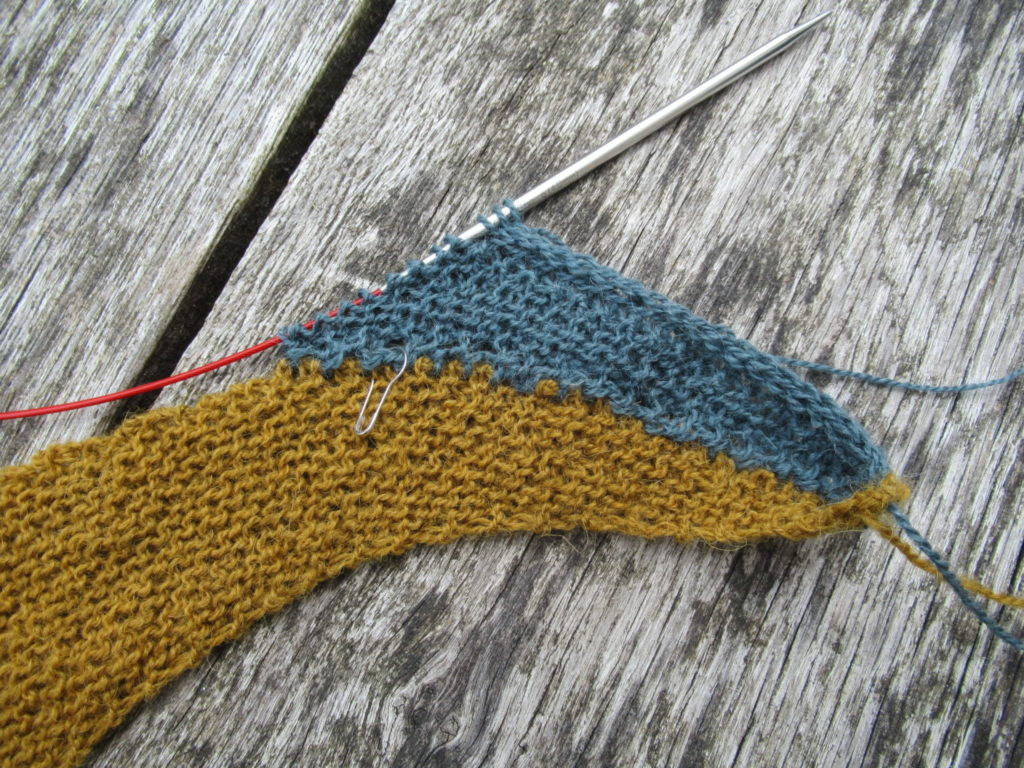
And then I thought: why don’t I write a blog post showing exactly what I’m doing, so that others won’t have to frog as much as did? So that’s what I’m working on now: knitting the rest of the shawl while taking photographs and making notes. If it works out, I’ll show you the results soon.
Note: The frog in the photo at the top of this post is a moor frog that hopped across our path during one of our recent walks. During the mating season the males turn blue for a few days. The frog may look quite big in the photograph, but it was only 5 centimeters (2 inches) long at most.
Finishing Granite
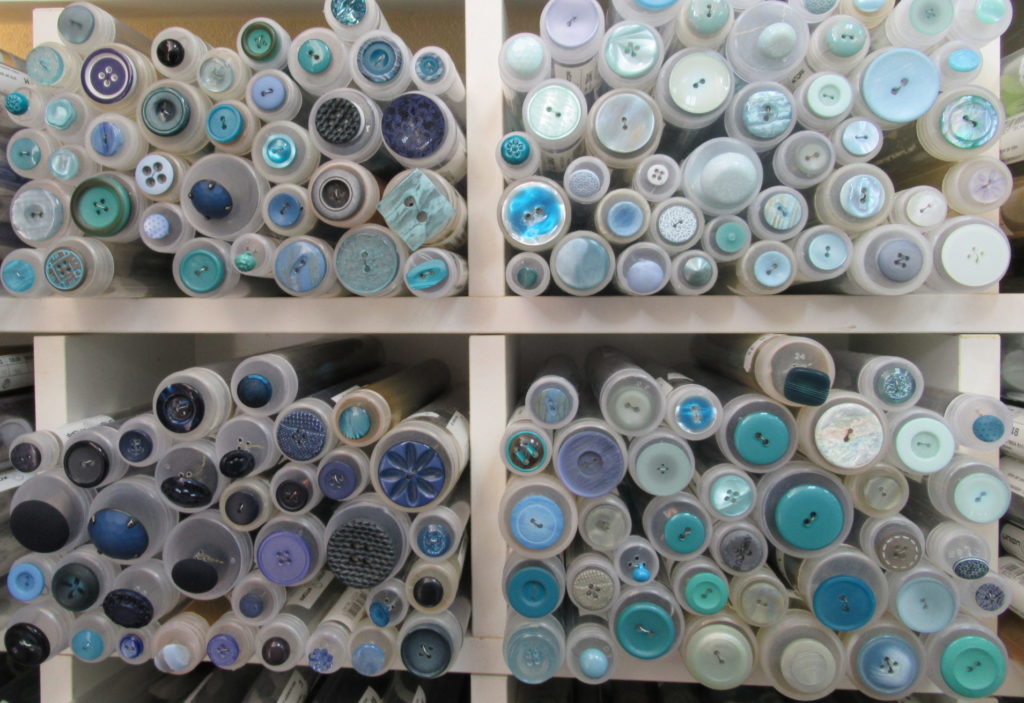
Finishing – weaving in ends, sewing seams – is my least favourite part of knitting. I’d rather start something new. So, while some people have skeletons in their cupboards, I have UFO’s (UnFinished Objects). Like a sweater with one sleeve, cardigans with just the buttons or pockets to sew on, a colourful scarf with a thousand ends to weave in, that sort of thing. Most UFO’s become FO’s in the end, but for some it takes a long, long time.
Now I’d like to mend my ways. I didn’t want to leave our daughter waiting for her new Granite cardigan for ages, so as soon as I finished knitting all of the pieces, I blocked them. Usually I don’t do this with garments, but only with lace shawls and other things that need opening up.
I gave the pieces a good soak, spun them lightly in the spin-dryer, and laid them out flat on my blocking mats – with blocking wires along the longest sides – and pinned them into place. I didn’t stretch them hard at all (as I would a lace shawl) but just to the size indicated in the schematics.
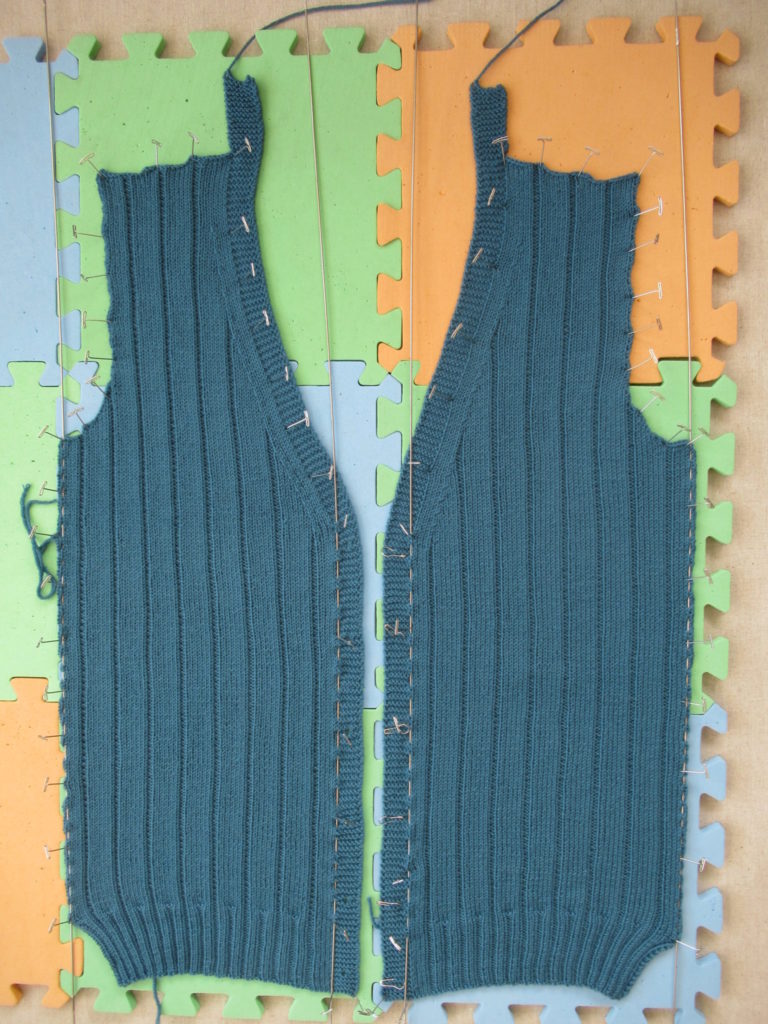
The pattern (Granite from Kim Hargreaves’ book Grey) said ‘Press all pieces with a warm iron over a damp cloth’. I gave it a try, but it soon became clear that that wasn’t going to work. As I wrote in another post, the combination of yarn and stitch pattern made the knitted fabric bunch up terribly. I could stretch it out in every direction, but it sprang back as soon as I let go.
I took some pictures of the knitted fabric before and after blocking, to show what the blocking did:
The fabric underwent a transformation. Dry it was elastic and springy. Wet it was limp (I have no other word to describe it). I tried to block the pieces very carefully to correspond with the sizes in the diagrams. Widthwise this was no problem, but lengthwise it was. They were much longer! The back and fronts were longer, the sleeves were longer, the armholes were wider. Yikes! Well, there was nothing I could do about it at this stage.
While the pieces were drying, I went looking for buttons. Now that is a part of the finishing process that I do like! I visited a great little haberdashery shop, with an impressive wall of buttons:
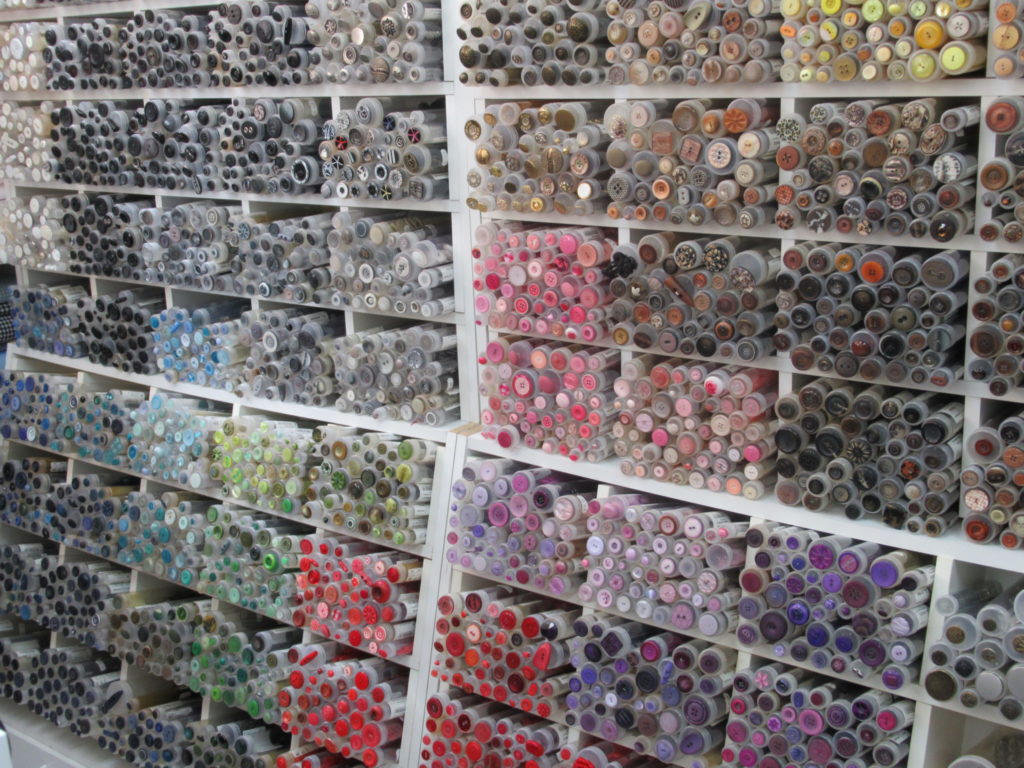
I zoomed in on the blue-green section and found several buttons that looked suitable. I spread the cardigan front out on the counter and placed some on the button band.
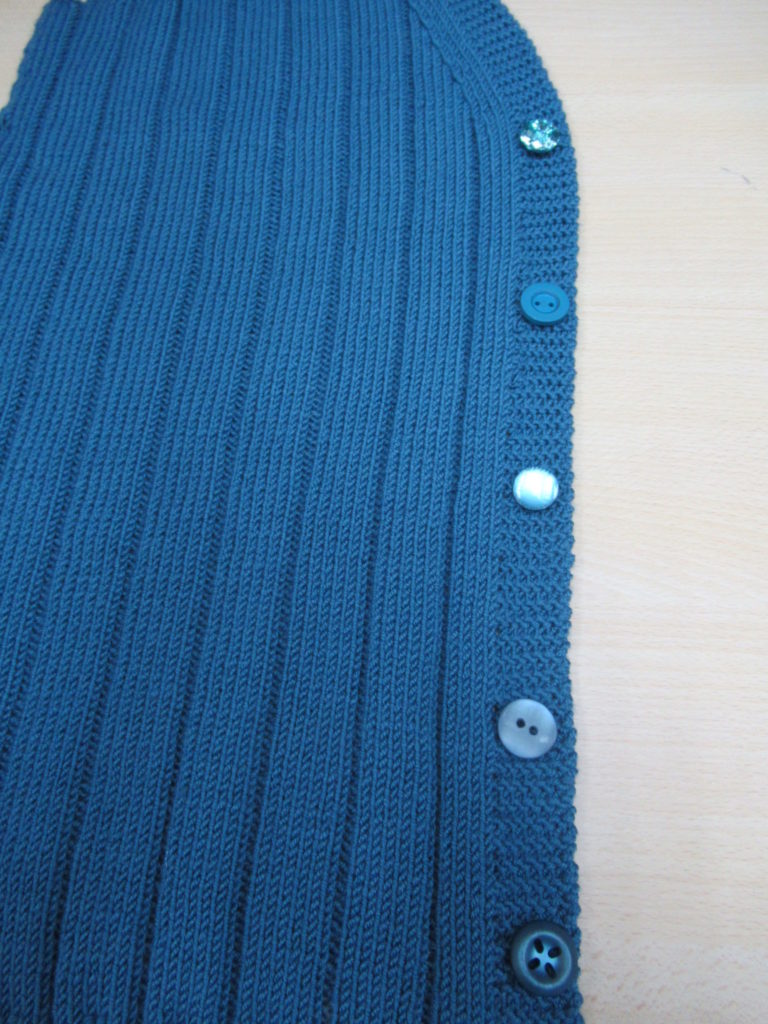
Now which one to choose?
The top button: too blingy
The second button: hmmm, maybe
The third button: too small
The fourth button: too dull
The fifth button: yes, I think this is perfect!
And then the two shop ladies (both several decades younger than me) had their say: It’s for your daughter, isn’t it? I wouldn’t choose the fifth button – that’s the granny option. (Ouch!) Take the second one. Much better!
Taking another look, I knew they were right. So, the second button from the top it was. Thanks for your help girls!
When they were dry, I didn’t sew the pieces together. I just pinned them, because I expected I’d have to rip them back and shorten them. But magically the cardigan fit!
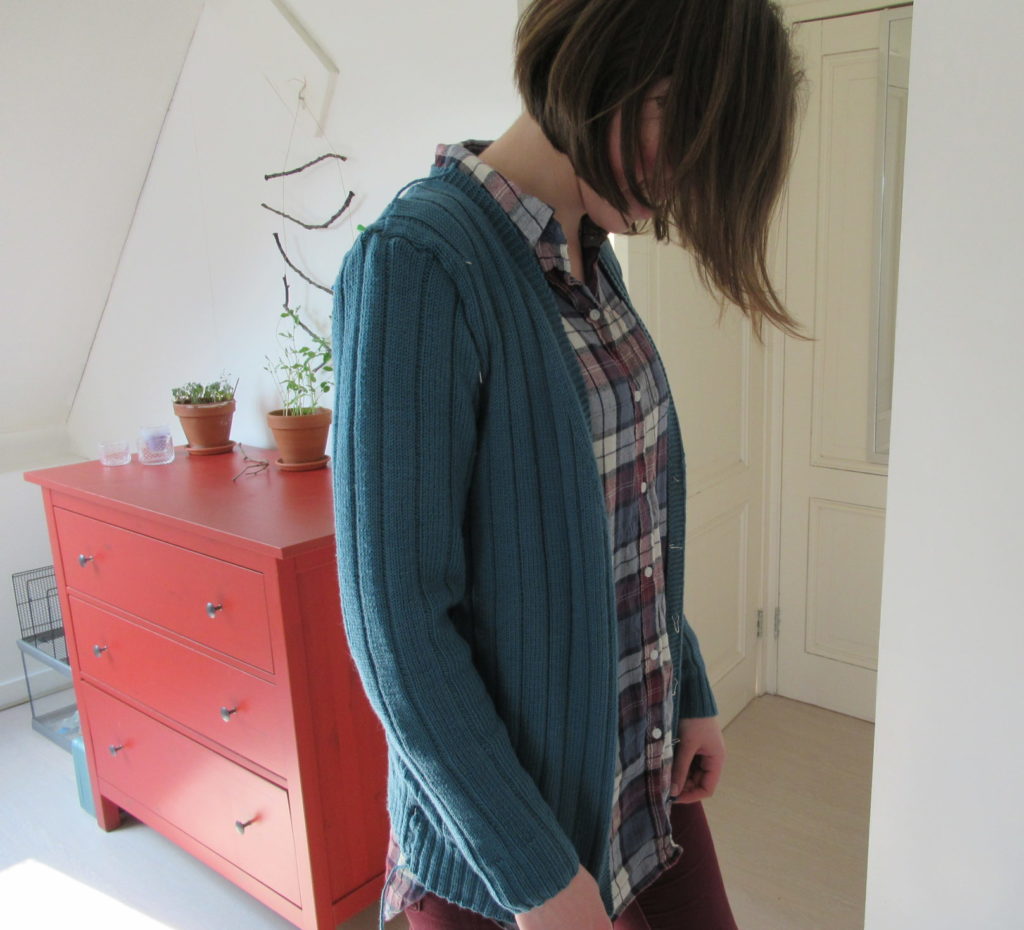
The sleeves were the right length and the armholes were just right. The body was slightly longer than planned, but that was fine.
Now I could set about sewing everything together. How could I make that unpleasant task more pleasant? Well, I collected everything I needed in a basket, put on a nice bit of music, lighted a scented candle and treated myself to a special cup of tea.
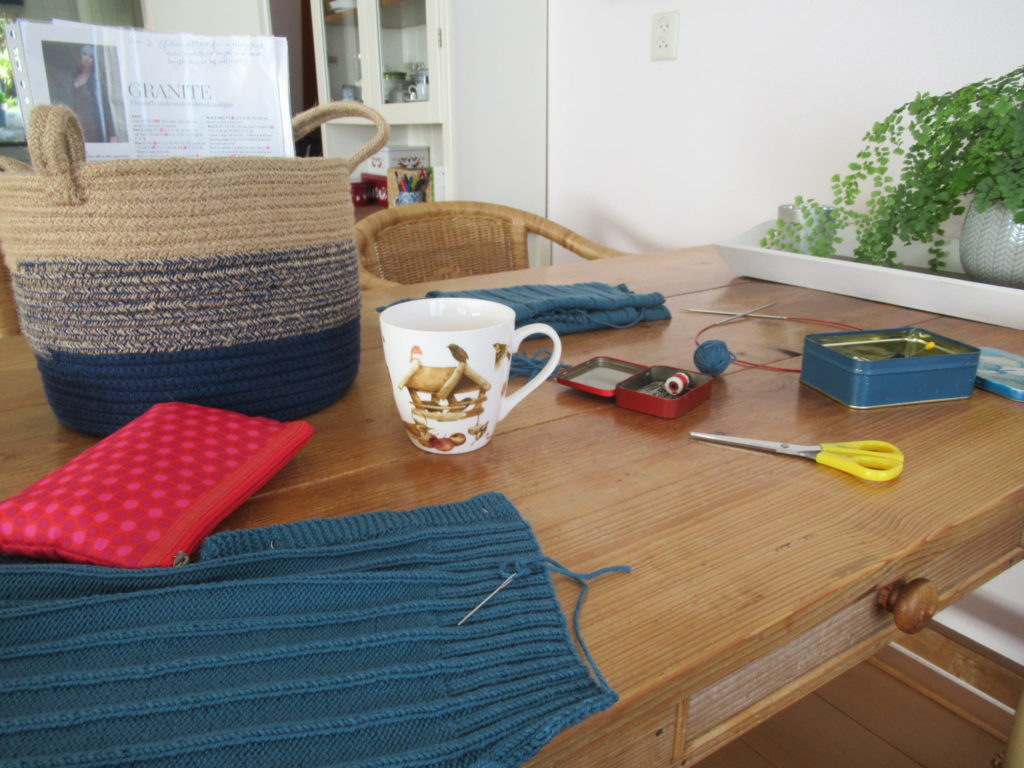
I also promised myself that I didn’t have to do it all in one sitting. Half an hour here, 45 minutes there, and before I knew it, it was finished.
During a lightning visit from our daughter, we did a quick photo shoot:
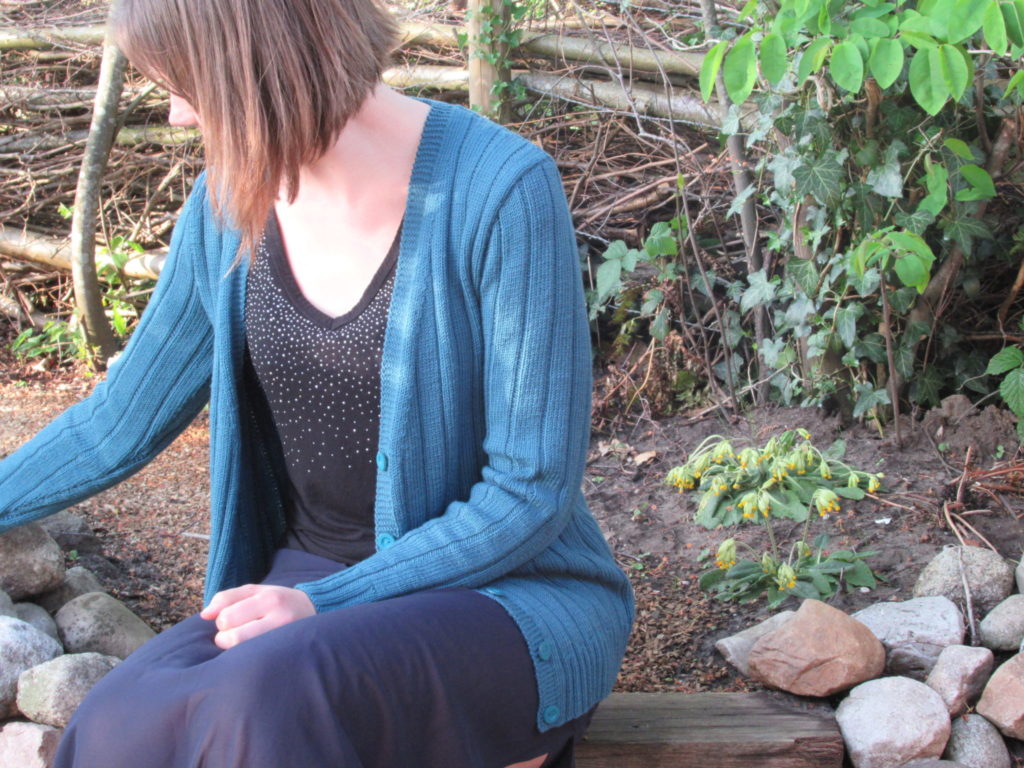
I joined most of the seams with an ordinary back stitch (on the wrong side), but for the band at the back of the neck I used a mattress stitch on the right side of the fabric. That way I was better able to see what I was doing, and got a flatter seam. I’m very happy with how this worked out:
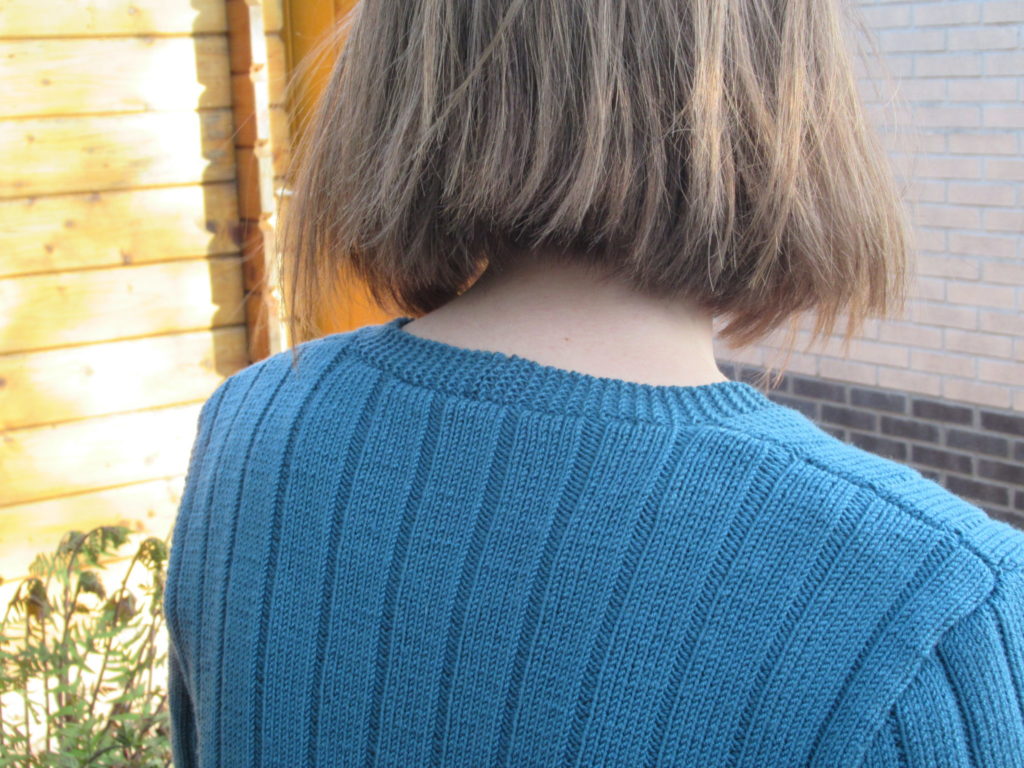
Taking beautiful photographs is a skill/art I need to practice a lot more. As you can see in this post alone, the colour of the yarn looks different all the time. In reality it is a medium dark teal (blue-green). The yarn I used is Rowan ‘Super Fine Merino 4-ply’:
As the name suggests, the yarn consists of 4 plies. Each one of these plies consists of 2 plies again, as you can see in the picture on the right. This construction makes the yarn very elastic, which caused some of the troubles I experienced.
I wouldn’t recommend this yarn to a beginning knitter, because it is very hard to get the measurements of the knit right, and also because it is easy to stick one’s needle into the yarn and miss one or more of the plies while knitting.
But all in all I’m really, really happy with it. After washing and blocking, the fabric is beautifully soft and smooth, with a subtle gleam, and a wonderful drape.
Here’s one last photo, which shows up the pretty decreases along the neckline very well.
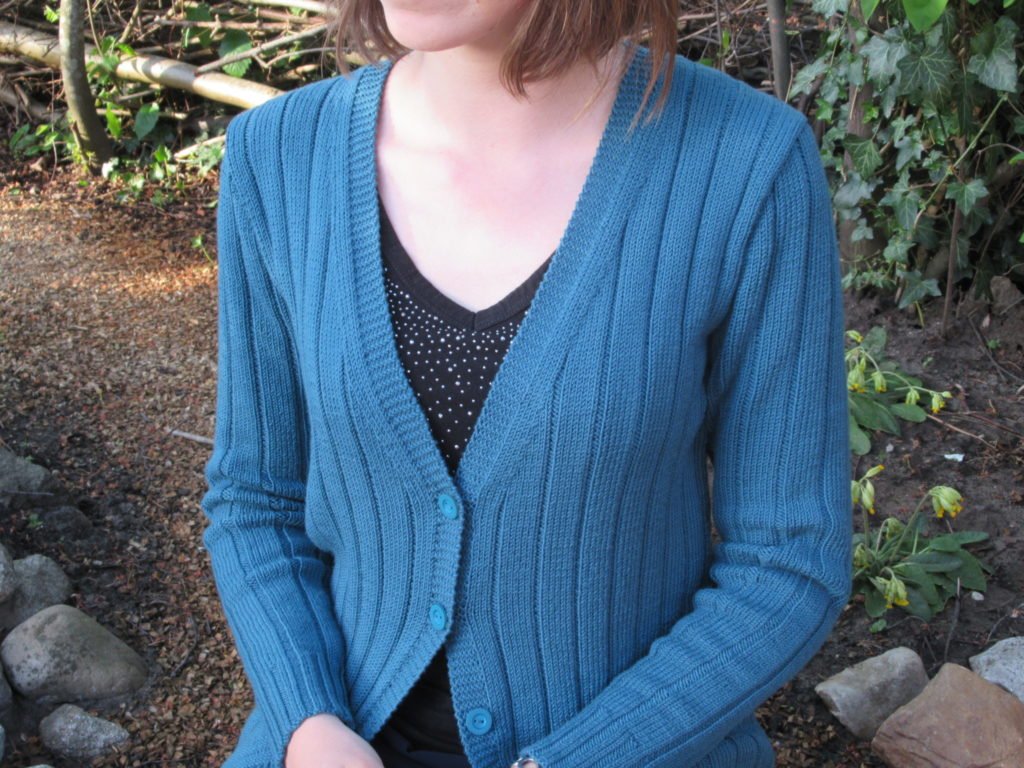
Thank you for reading. I know I’ve gone rather more into technical detail than I’ve done so far. I hope it was interesting nevertheless. If you’re a Ravelry member and would like even more details (yarn quantities, needle sizes etc.) you can find them here on the project page.
Now on to something new!
Festive I-Cord and Winter Tea
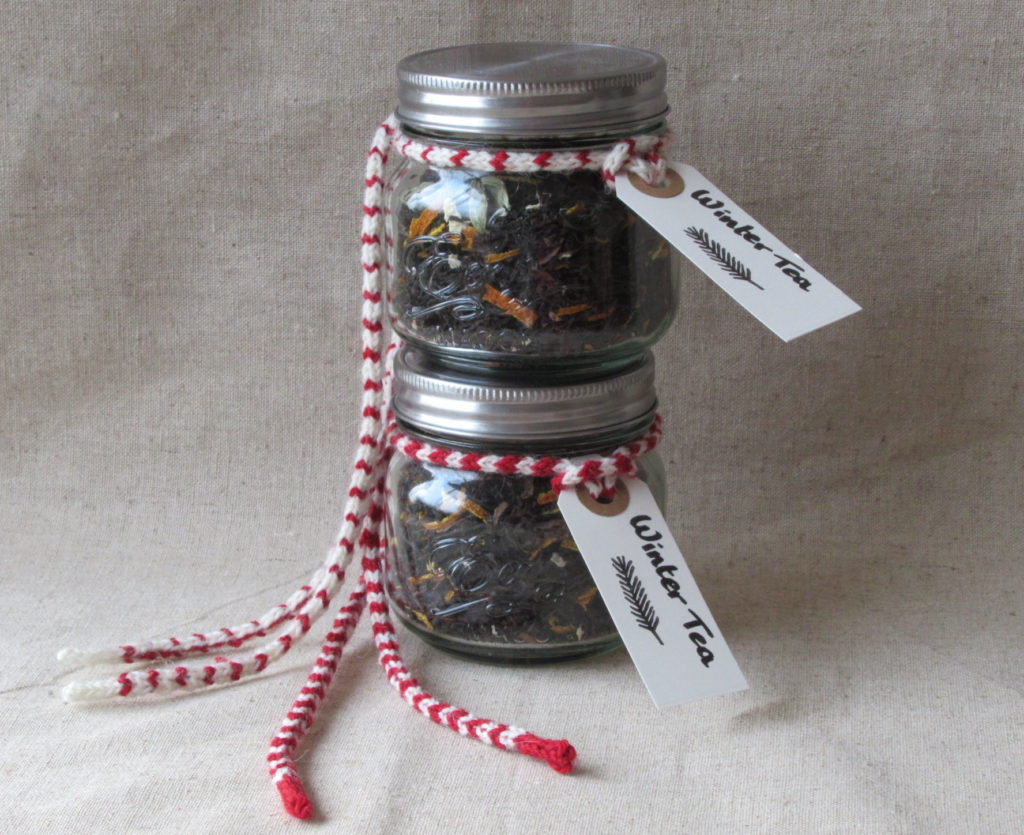
For us, Christmas is not about presents. Our big gift-giving moment is on December 5th, the feast of Saint Nicholas. For us, this time of the year is about celebrating togetherness, darkness and light, and good food. And for me, it is also a time to reflect, rest, read and knit.
Still, there is always someone who could do with a small present – a host, someone who has moved house, or ‘just’ a dear friend. For such occasions I have made some warming Winter Tea, with orange zest and spices. I’ve written the recipe down and included it further on in this blog post.
Making the tea is really nice, cutting and drying the zingy orange zest, crushing the spices, and mixing the fragrant blend. But what is even nicer, is knitting the cords to decorate the jars. It would be much quicker to use string, raffia or ribbon, of course. But knitting this cord is so much fun and brings a quirky, personal touch.
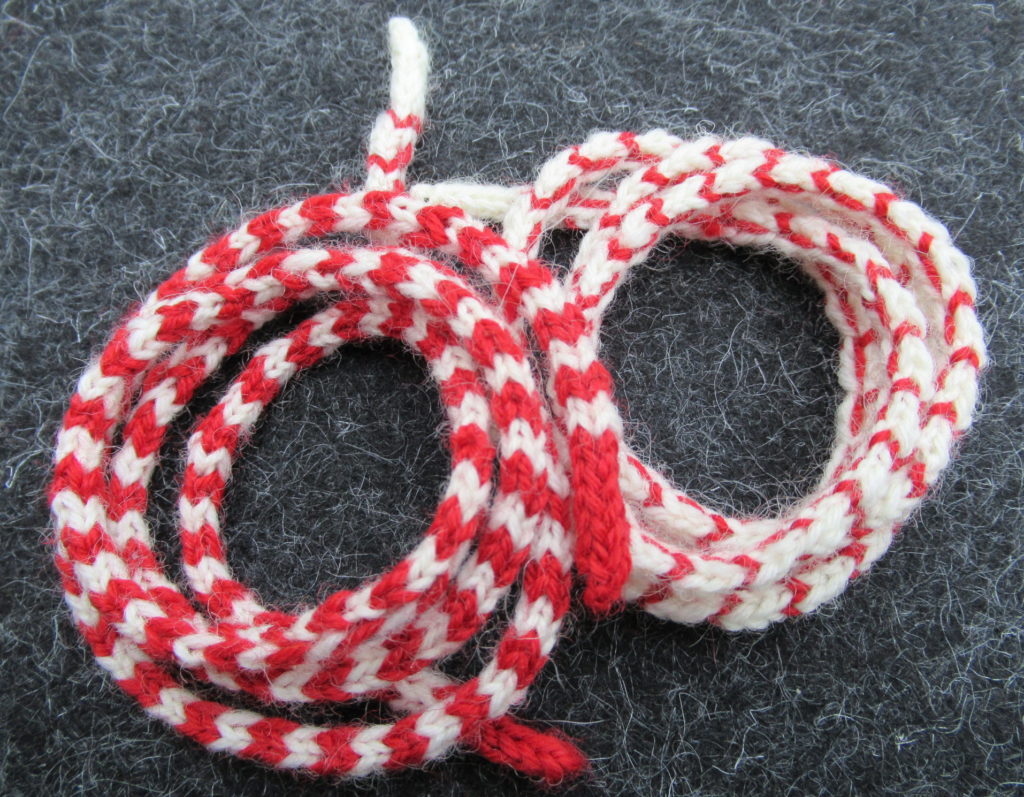
I-cord
This type of knitted cord is usually called I-cord. Why? Something to do with iPhones and iPads perhaps? No, as it turns out, the ‘I’ stands for ‘idiot’. This cord is so easy to knit that every idiot can make it. I-cord was made famous by the innovative knitting teacher Elizabeth Zimmermann, and can be used in many different ways – along the edges of knitted fabrics or separately, like I used it here.
For a cord like this you’ll need some scraps of fingering-weight (sock) yarn in two colours and two double-pointed knitting needles (I used 2.5 mm).
Knitting the I-cord:
- Cast on 1 stitch
- Knit into the front, the back and the front of the stitch (= 3 stitches)
- DO NOT TURN! Move the needle from your right to your left hand and slide the stitches to the right tip of the needle.
- Knit the 3 stitches, pulling the yarn firmly (but not too tight) at the first stitch.
Repeat steps 3 and 4 to the desired length. (I knit to about 70 cm/28 inches).
To cast off slip the first stitch, knit the next two stitches together, pass the slipped stitch over this stitch, cut the thread and pull it through the last stitch. Weave in ends.
For the cord on the left in the photo above I knit 2 rows red and 2 rows natural white. For the cord on the right I alternated 3 rows natural white with 1 row red.
And then I played some more with the yarn:
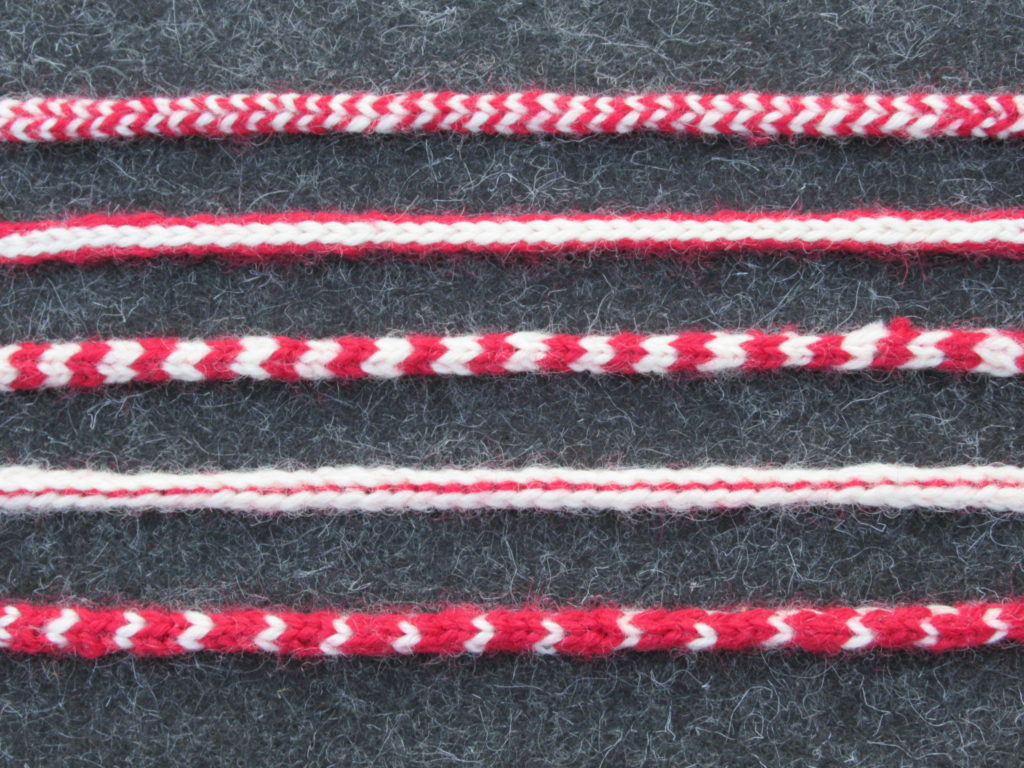
It’s amazing what you can do with just 3 stitches and 2 colours of yarn. The hardest thing about I-cord is keeping an even tension. Don’t worry too much about that, though. Nobody will notice. As you can see from the photo above, my tension is not all that even. But do you notice that looking at the I-cords on the jars? Not really.
Winter Tea Recipe
You’ll need:
- Dried zest of 1 orange (see below)
- 100 grs black tea (e.g. Ceylon)
- 8 cloves
- 1-2 cinnamon sticks (depending on size)
- 15 cardamom pods
- 10 black pepper corns
- 2 teaspoons dried ginger
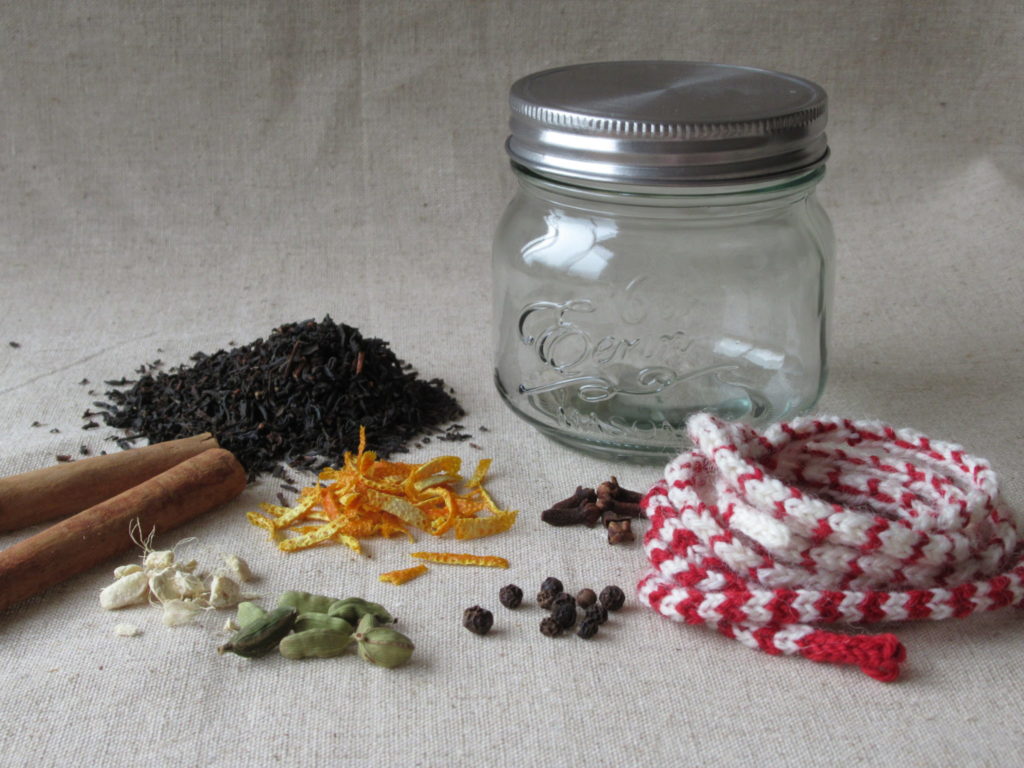
To dry the orange zest, preheat the oven to 100 °C / 210° F / 90 °C fan. Peel the orange thinly using a potato peeler. Cut the zest into tiny strips. Spread the strips of zest out on a baking tray and place in the oven for about 1 hour, until completely dried out and brittle. Leave to cool.
Break the cinnamon sticks into pieces. Crush the spices (not the orange zest!) using a pestle and mortar. Use some force, but not too much. The spices should still be recognizable and not pounded to a powder.
Mix the spices with the tea and the dried orange zest and fill into jars. (This quantity is enough to fill two 240 ml jars.)
Make a nice gift tag and fasten it with your I-cord.
The tea is even better served with a slice of fresh orange.
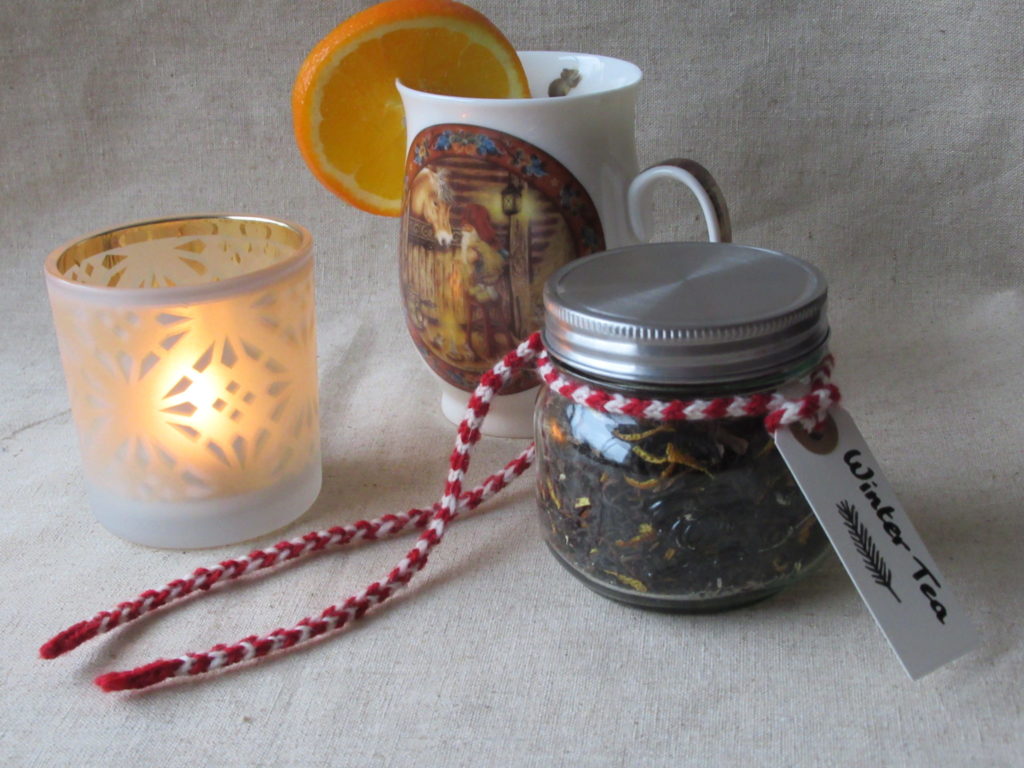
Last but not least
Remember to take some time to make yourself a cup of tea, sit down, sip and relax.
I wish you a very happy and peaceful holiday season and look forward to seeing you again (in real life or here) in the New Year!
